We all need food to live. But different foods are also fascinating to learn about. Some foods are actually mislabeled and grouped incorrectly. Other foods have morphed throughout the years. And even other foods are just plain gross! These fun food facts are perfect for sharing with your students, and we’ve created free slides for each one of them too. Post one during your morning meeting or share them all during a science lesson.
Jump to:
- Fruits and Veggies Food Facts
- Spices, Nuts, and Seeds Food Facts
- Sweet Treats Food Facts
- Gross but Fun Food Facts
- Savory Food Facts
- Surprising Fun Food Facts
- Record-Breaking Food Facts
Fun Food Facts About Veggies and Fruits
A healthy diet includes lots of fruits and vegetables, and kids are pretty familiar with a lot of them. These fun facts are sure to surprise and amaze them!
1. Applesauce was the first food eaten in space.

John Glenn ate applesauce during the Friendship 7 flight in 1962. For more, watch this video about space food prep!
2. Broccoli contains more protein (per calorie) than steak!
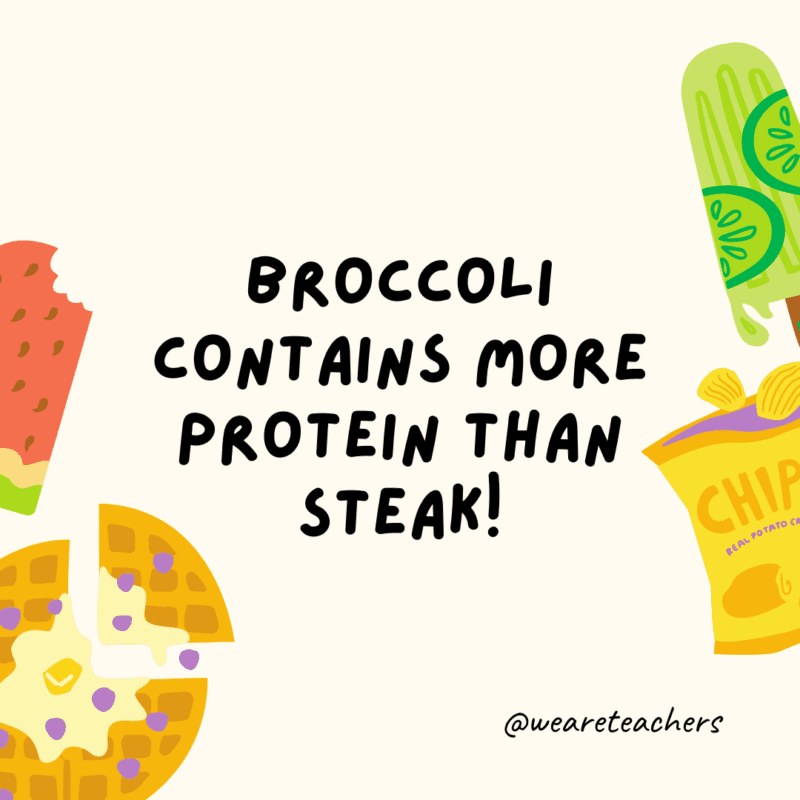
Broccoli contains more protein per calorie than steak, but you would have to eat a LOT more broccoli!
3. Raspberries are a member of the rose family.

Actually a lot of fruits belong in the rose family! Blackberries and strawberries are also members of the Rosaceae family. And trees that bear fruit in the rose family include apple, pear, plum, cherry, apricot, and peach.
4. Potatoes were the first food planted in space.
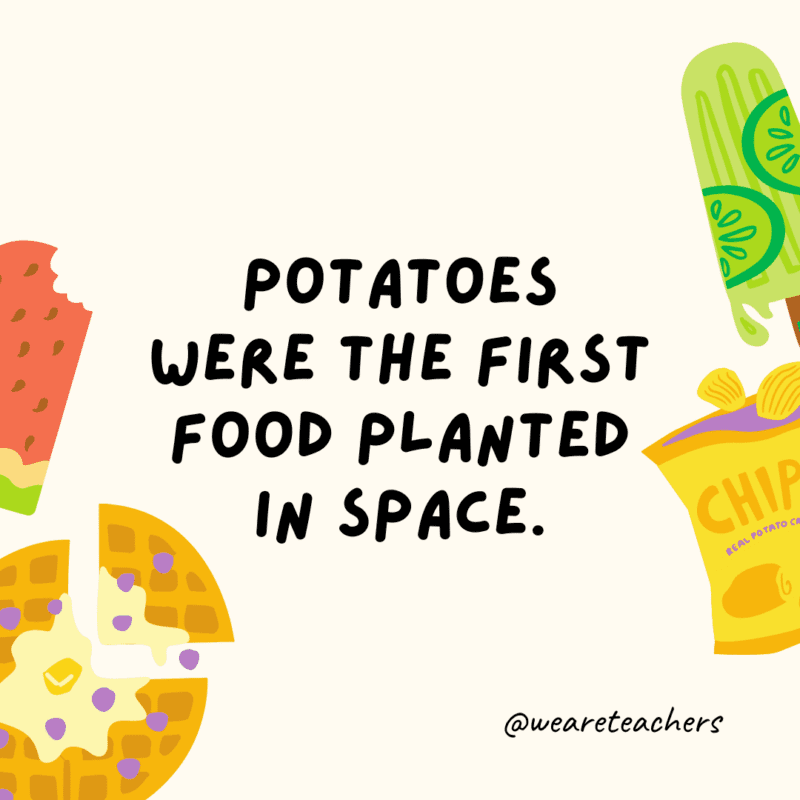
In October 1995, the University of Wisconsin, Madison, created the technology to plant food in space, and potatoes were the first food grown there! The goal was to feed astronauts on long space voyages. Learn more about growing food in space in this video.
5. Cucumbers are 95% water.

As part of your diet, cucumbers can help hydrate you. Along with cucumbers, other vegetables high in water content are lettuce, celery, bok choy, radish, zucchini, green bell peppers, and asparagus.
6. Figs aren’t fruits, they are flowers.

Even better, they are inverted flowers! Fig trees have flowers that bloom inside the pod, which then matures into the fruit we eat.
7. Pineapple plants can take two to three years to produce a fruit.
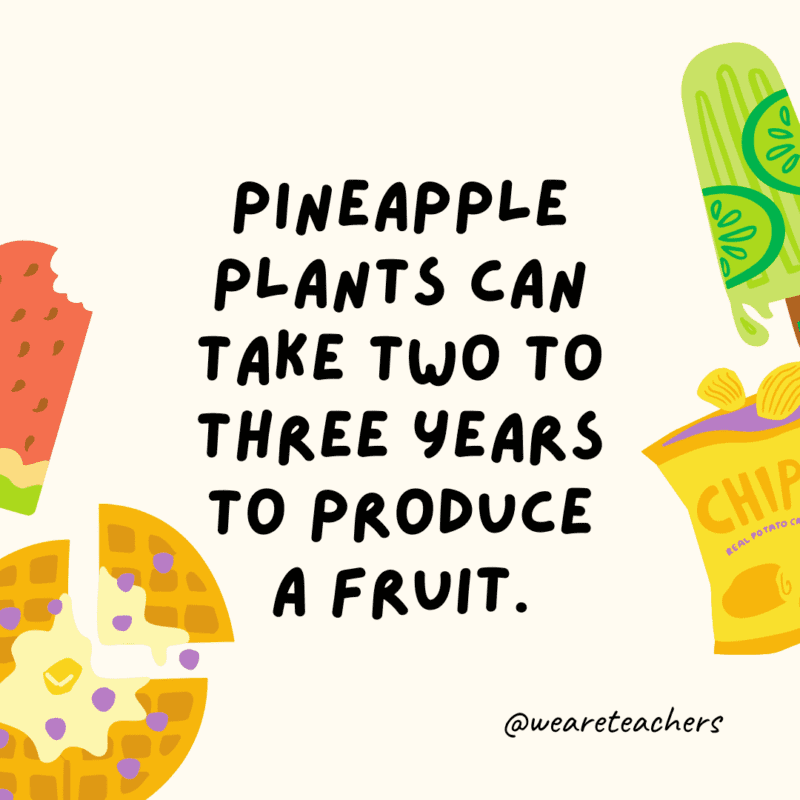
While pineapple plants can grow only one fruit at a time, some live up to 50 years!
8. Watermelon and bananas are berries, but strawberries are not!
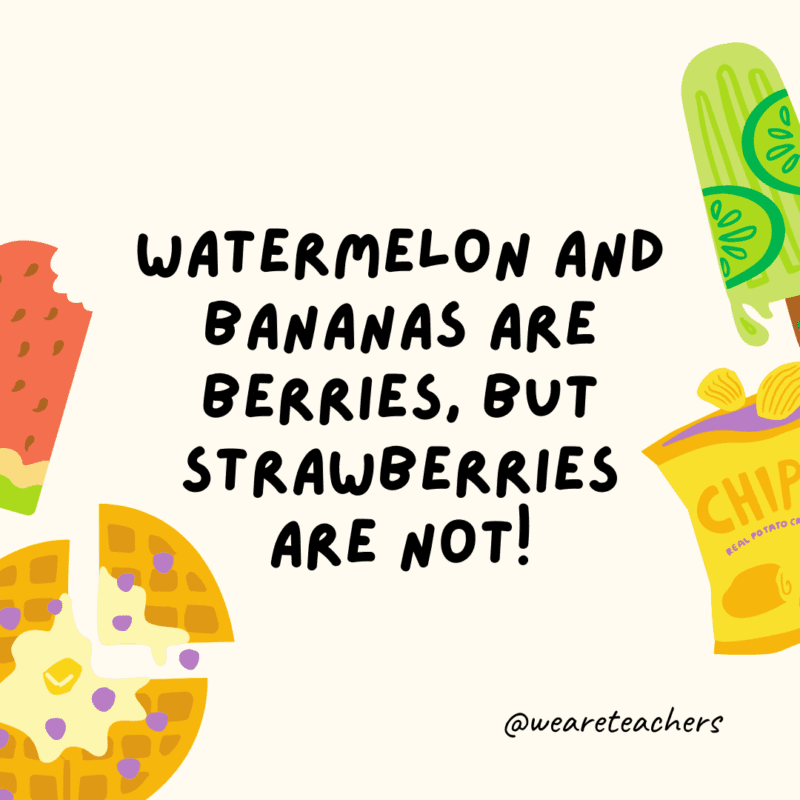
A lot of thought goes into classifying fruits and vegetables, and it all has to do with anatomy. Learn more here.
9. Rhubarb grows so fast, you can hear it!

As the buds crack open, it makes a sound (some say it “sings”). Some people say there’s a constant creaking during growing season.
10. Glass Gem corn has rainbow kernels that look like little beads of glass.

Carl Barnes, a part-Cherokee farmer living in Oklahoma, bred corn to get these beautiful results.
11. Fruit salad trees grow different fruits on the same tree!

These are called multi-grafted trees, and they can grow up to eight different types of fruit at a time.
12. Lemons float but limes sink.
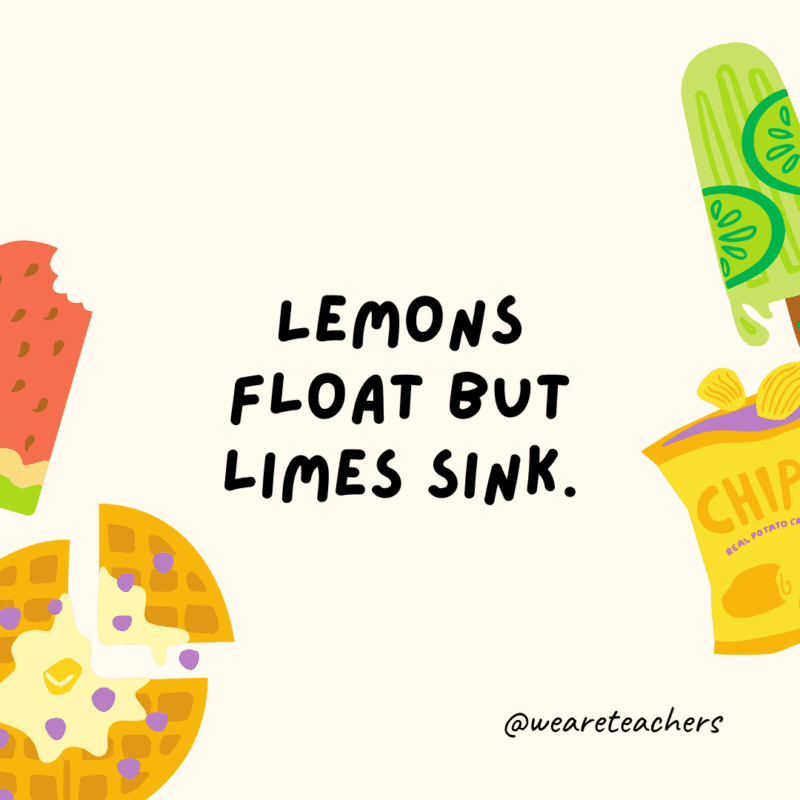
Learn more about the buoyancy of lemons, limes, and oranges here!
13. Carrots were once purple and yellow, not orange.

The first records show that carrots were purple and yellow until the 1400s or 1500s.
14. Carrots are sweeter in the winter.
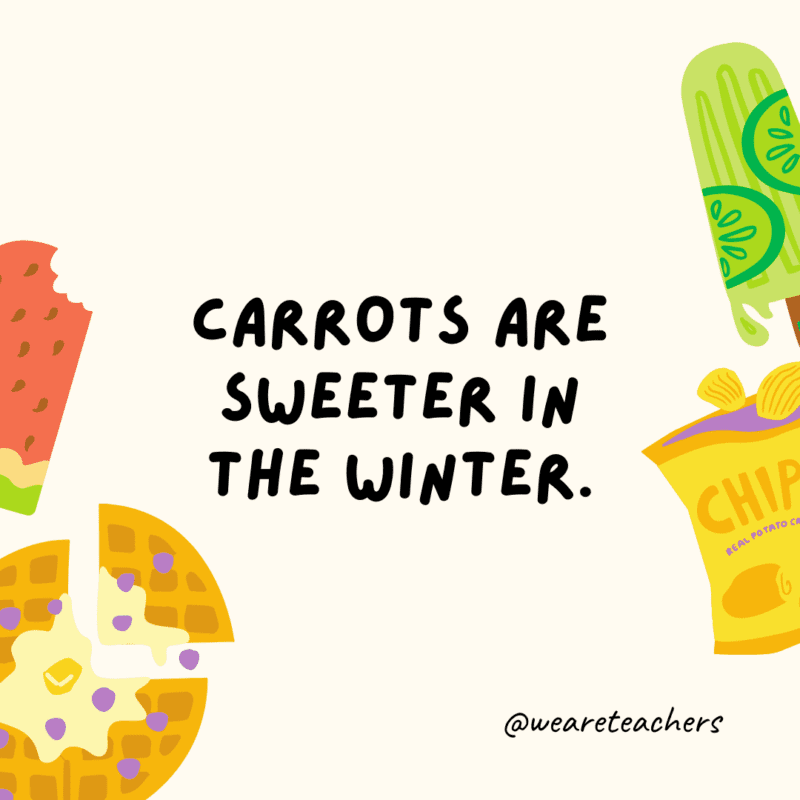
Carrots developed the physiological response of increasing their sugar content when it’s cold outside to stop ice crystal formations that cause damage. Check out this video for more!
15. Avocados are fruit.
Though you often find them in savory dishes like guacamole, avocados are technically fruit. Unlike many fruits and veggies, they’re high in fat, but that doesn’t mean they’re unhealthy. Avocados contain unsaturated fats, which help lower LDL (bad) cholesterol.
16. Some wasabi is actually horseradish.
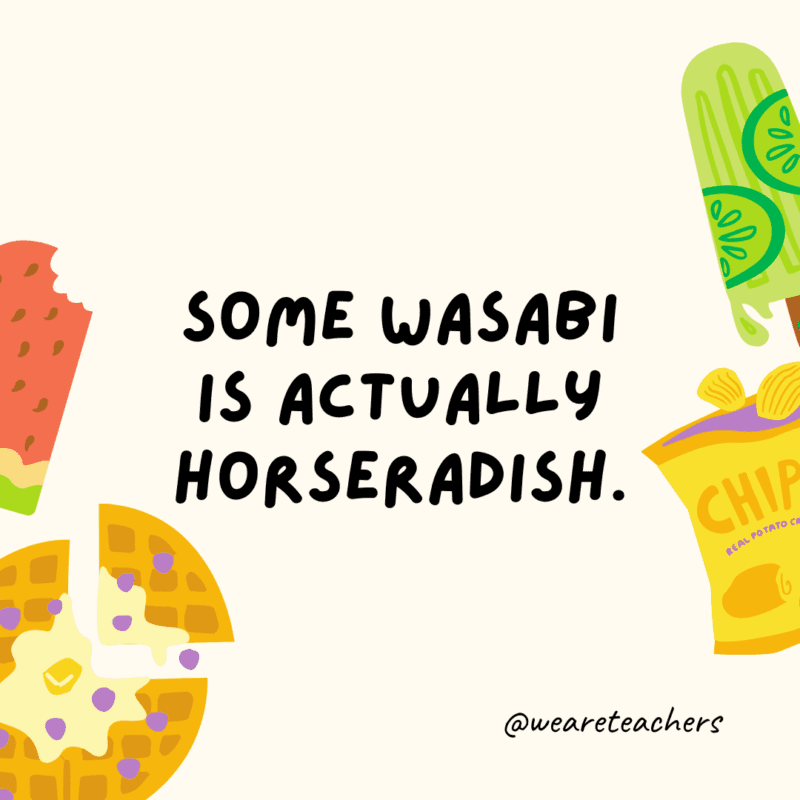
In fact, most supermarket wasabi is actually horseradish. It’s expensive and difficult to make real wasabi so a lot of stores sell colored horseradish instead. Check the ingredients to see what your spicy green paste is actually made of.
17. You can bounce ripe cranberries.
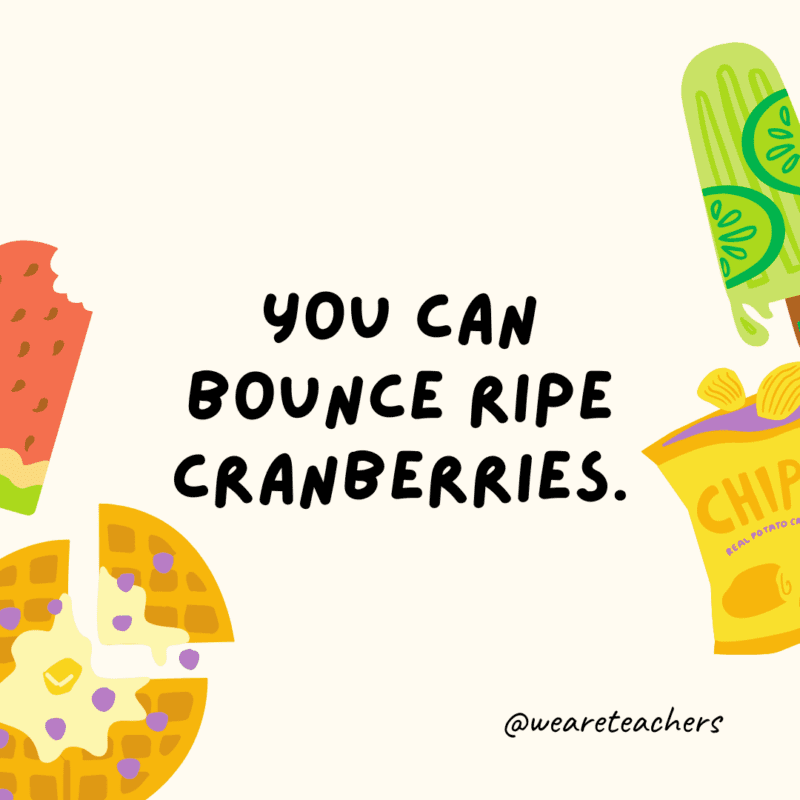
It’s easy to find out when cranberries are ripe—just drop some on the ground! If they bounce, they are perfect. Even farmers use this test!
18. Potatoes are 80% water.
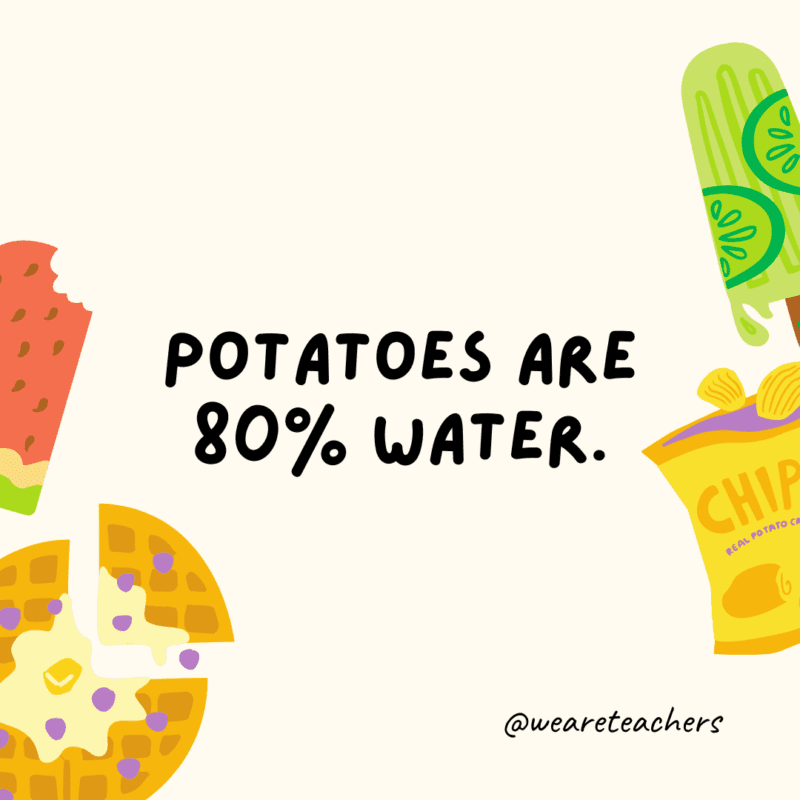
You could probably juice a potato, but we’ll stick to mashed potatoes and fries!
19. You can find square watermelon in Japan.
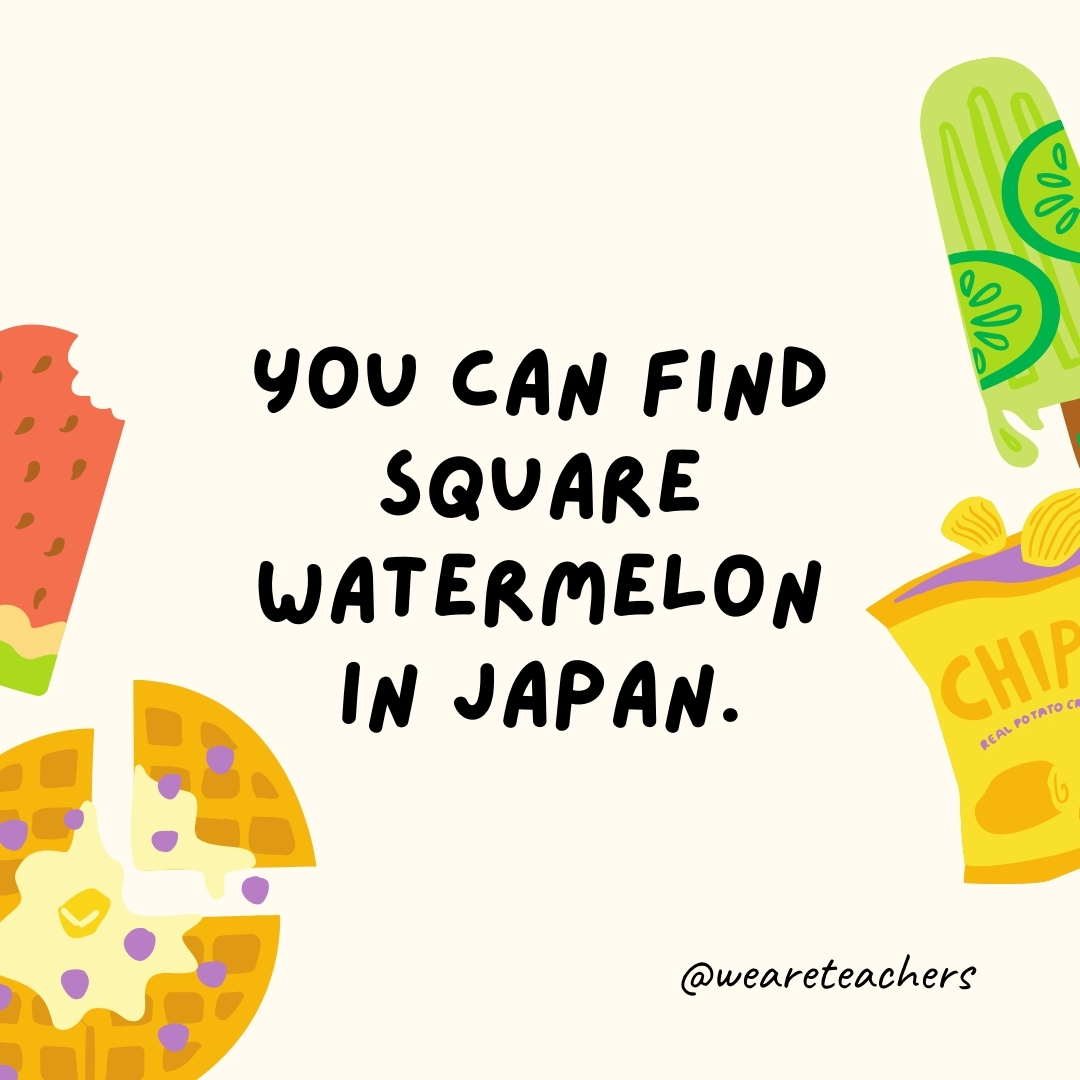
Add this to your list of surprising fun food facts. In Japan, farmers grow square watermelons by cultivating them in square containers. They’re easier to stack and store but are more of a novelty than a regular product due to their high price.
20. Tomatoes are actually fruit, but they are legally vegetables.

The U.S. Supreme Court ruled in 1893 that tomatoes are vegetables for taxation purposes. But botanically, they are fruits.
21. Apples are 25% air.

This is why they float in water.
22. Lettuce is a member of the sunflower family.

This common salad ingredient is related to sunflowers.
23. Eggplants aren’t always purple.
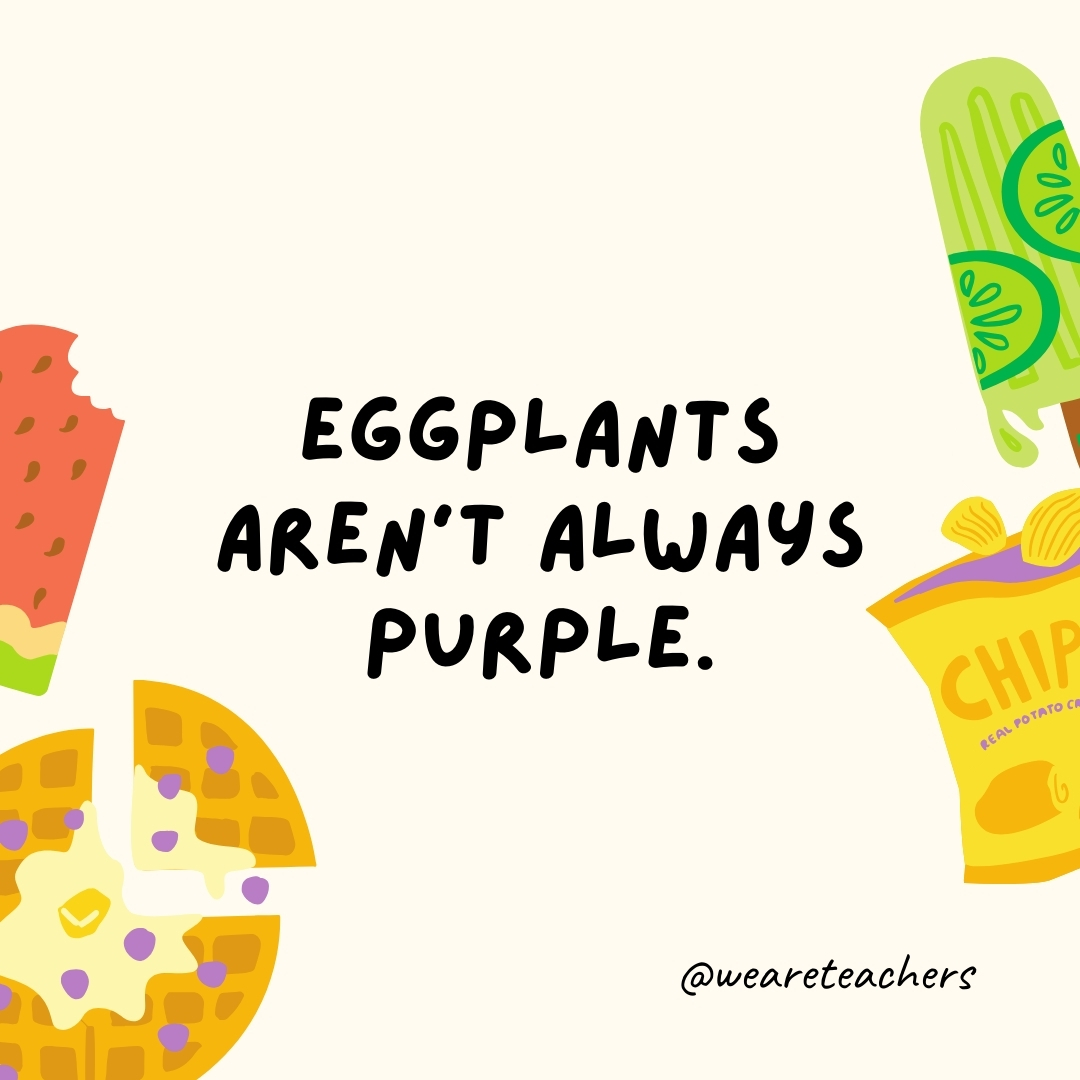
They can come in a range of colors, including orange, green, and even white.
24. Oranges weren’t originally orange.
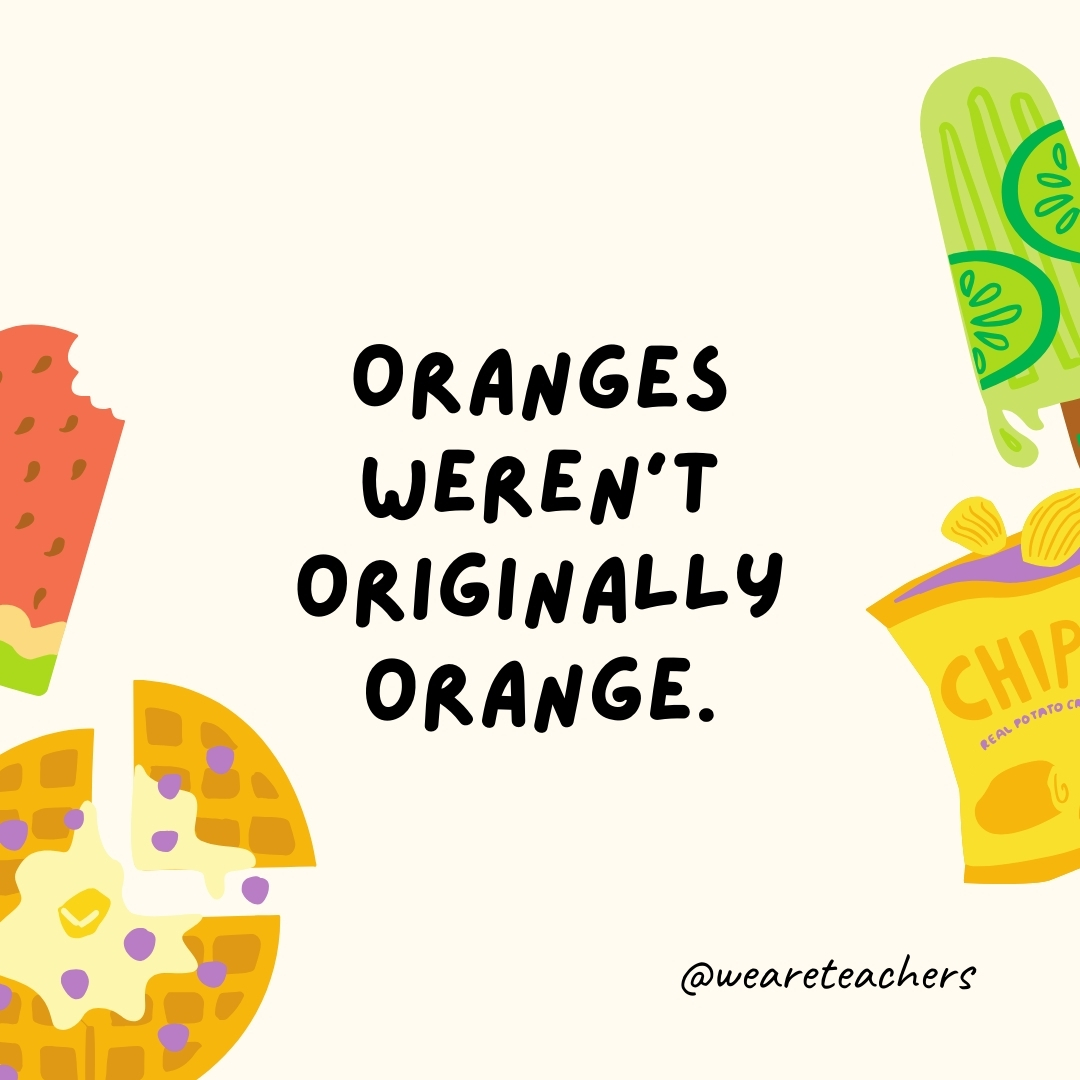
This is one of those food facts that is equally fun and surprising. The original oranges from Southeast Asia were a tangerine-pomelo hybrid, and they were green. In fact, oranges in warmer regions like Vietnam and Thailand still stay green through maturity.
25. Wasabi takes up to two years to grow.
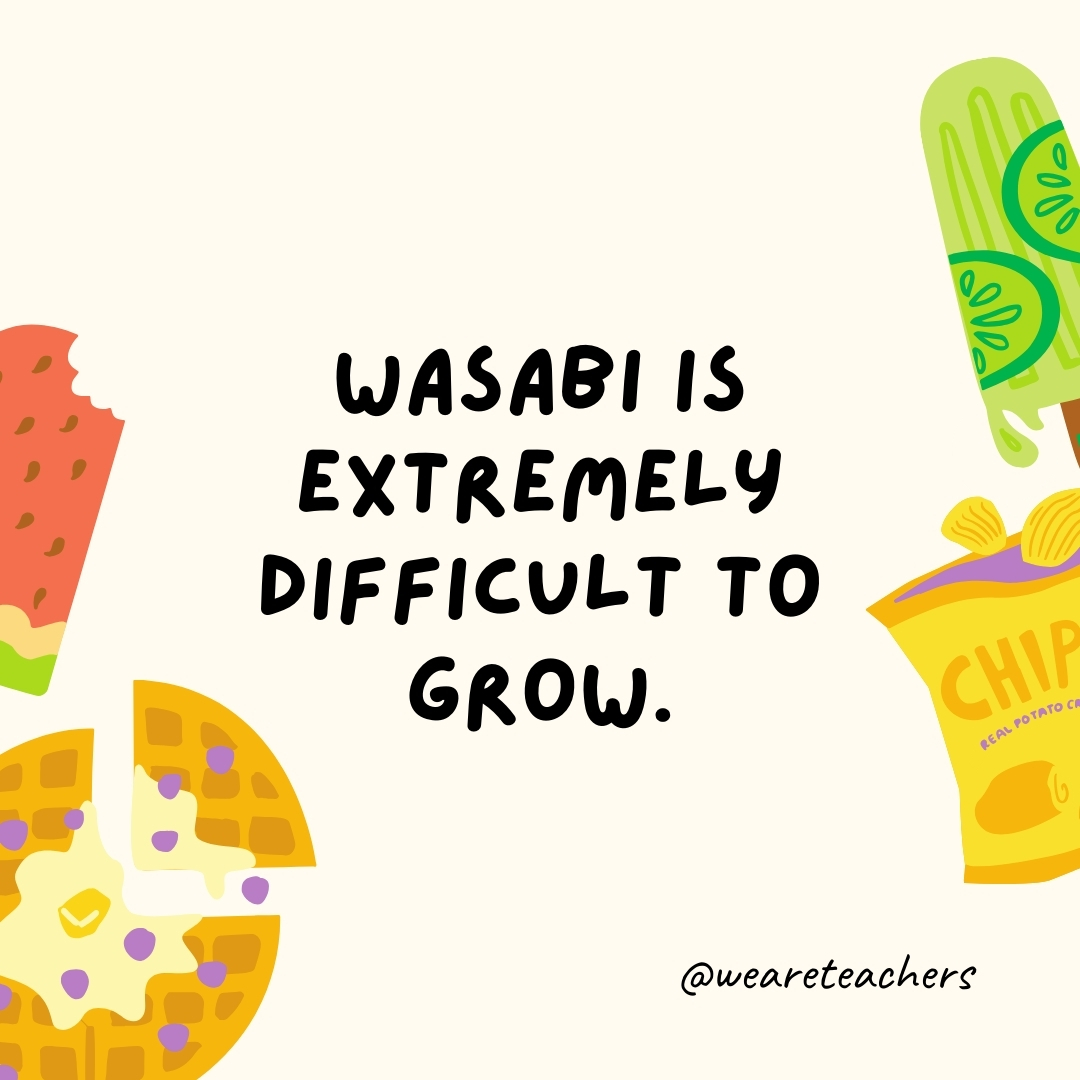
Real wasabi is one of the most difficult plants to grow commercially. The plant requires a stream of running water and can take two years to fully mature.
26. A cluster of bananas is called a hand.

A single banana is called a finger.
27. There are over 7,500 varieties of apples.
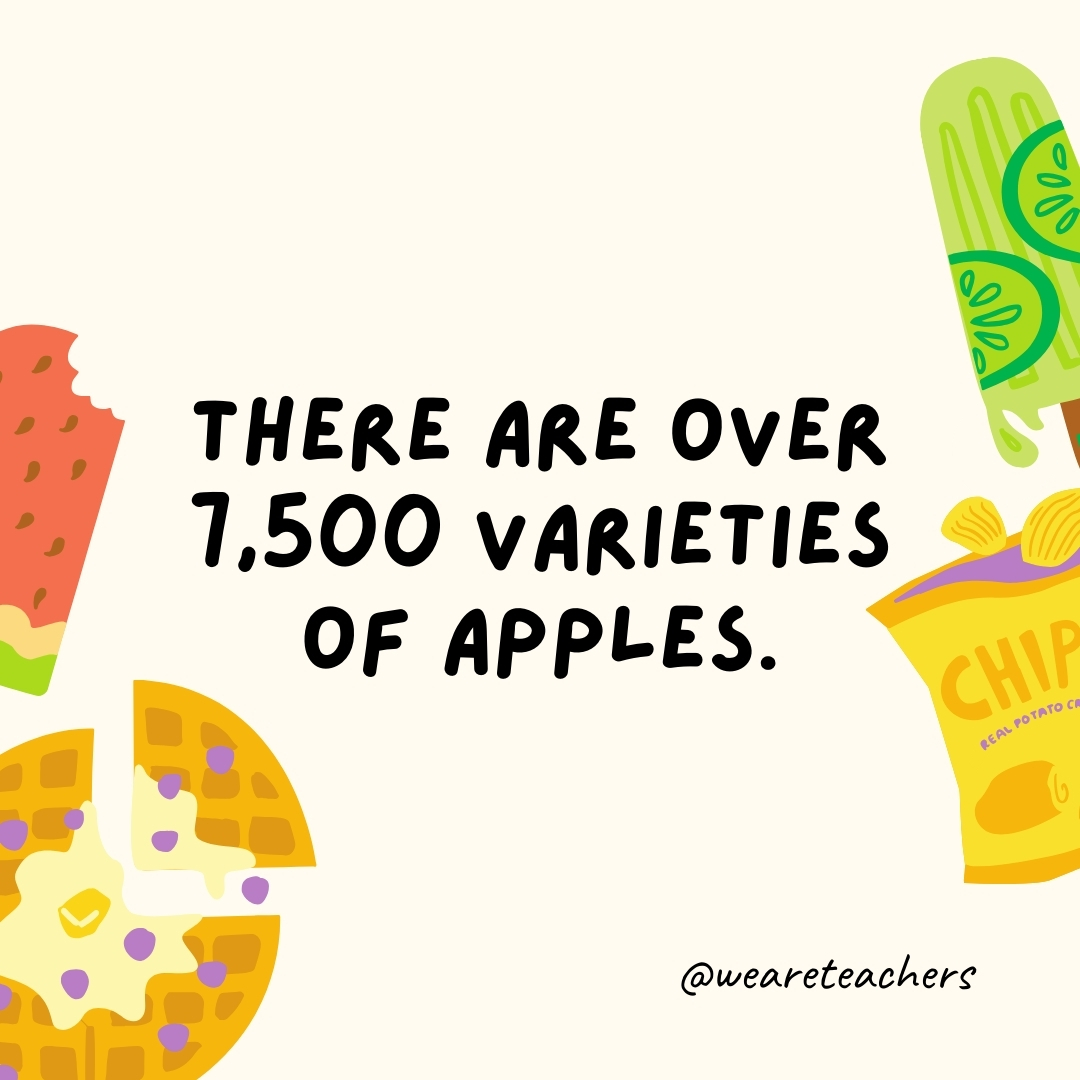
It would take years to try them all if you ate a different apple each day.
28. One apple tree can produce up to 400 apples a year.

Depending on its size and variety, a single apple tree can produce between 130 and 400 apples a year.
29. Stickers on fruit are edible.
While the FDA doesn’t recommend eating them, those stickers are nontoxic and generally safe to consume. So if you accidentally snack on a sticker along with your first big bite of a juicy apple, there’s no need to worry.
Food Facts About Spices, Nuts, and Seeds
It turns out a lot of nuts aren’t actually nuts. Learn which ones are trying to fool you, along with other fun facts.
30. Pistachios aren’t nuts—they are actually fruits.
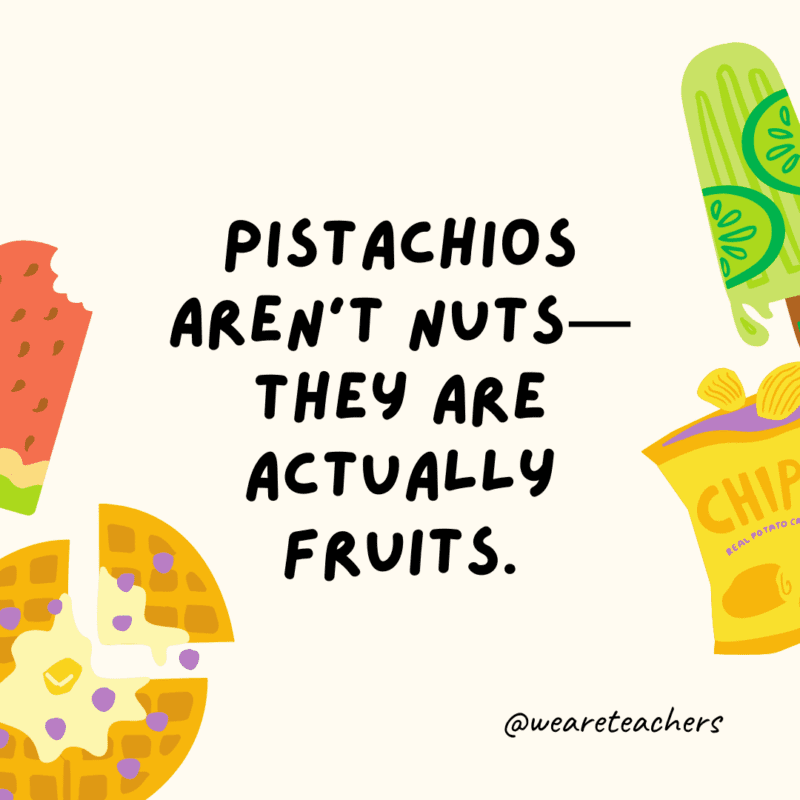
Pistachios are unusual. Though they’re sold as nuts, they’re actually a “drupe,” a fleshy tree fruit containing a shell-covered seed. (They’re not the only ones—you’ll find some other “not nuts” on this fun food facts list too!)
31. Almonds are not nuts—they’re seeds.
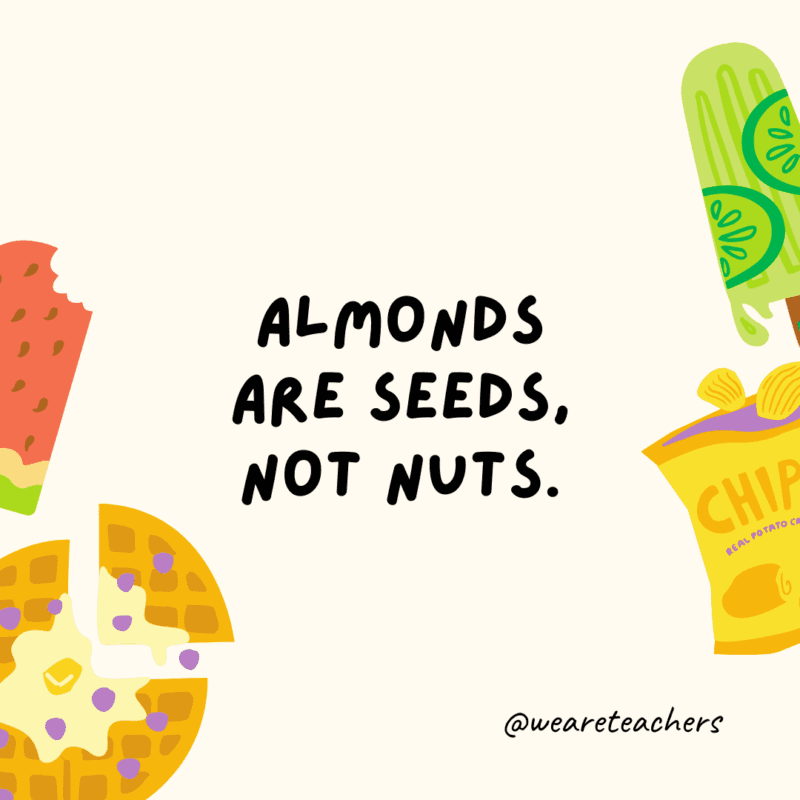
Here’s another one! Almonds are actually seeds of an almond fruit, so they’re not nuts either.
32. Cashews grow on cashew apples.

See how cashews grow in this video!
33. Nutmeg can make you hallucinate.

A little bit of nutmeg is tasty, but don’t eat too much. In large doses, the seasoning can have mind-altering effects due to a natural compound called myristicin.
34. One in four hazelnuts is used to make Nutella.
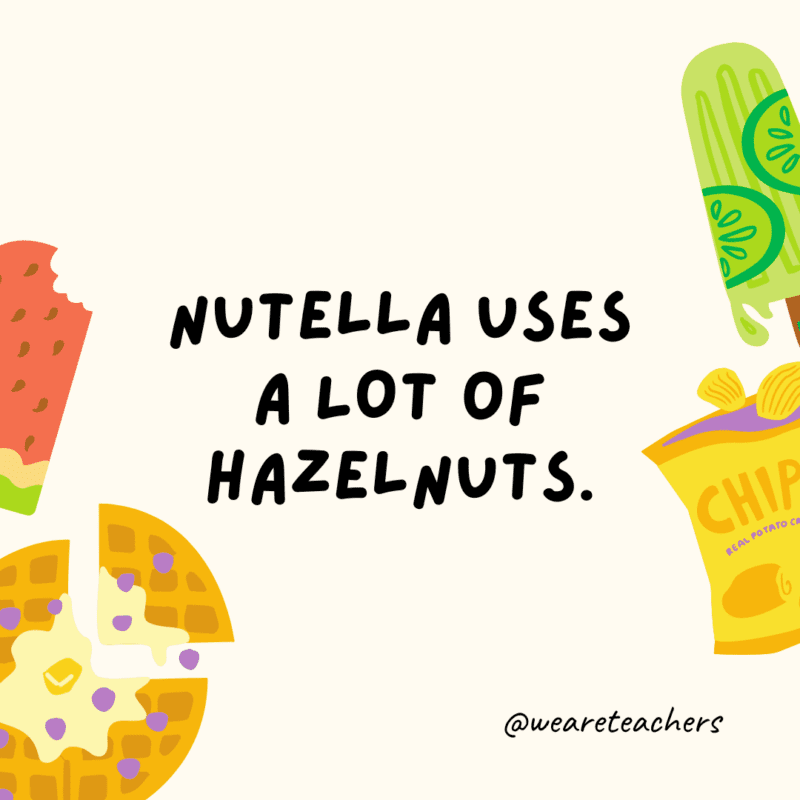
You can’t deny the popularity of this tasty spread! At least 25% of hazelnuts are used to make Nutella, with some universities even trying to find ways to grow them in labs to help offset global shortages.
35. Saffron is very expensive due to the complicated process required to harvest it.
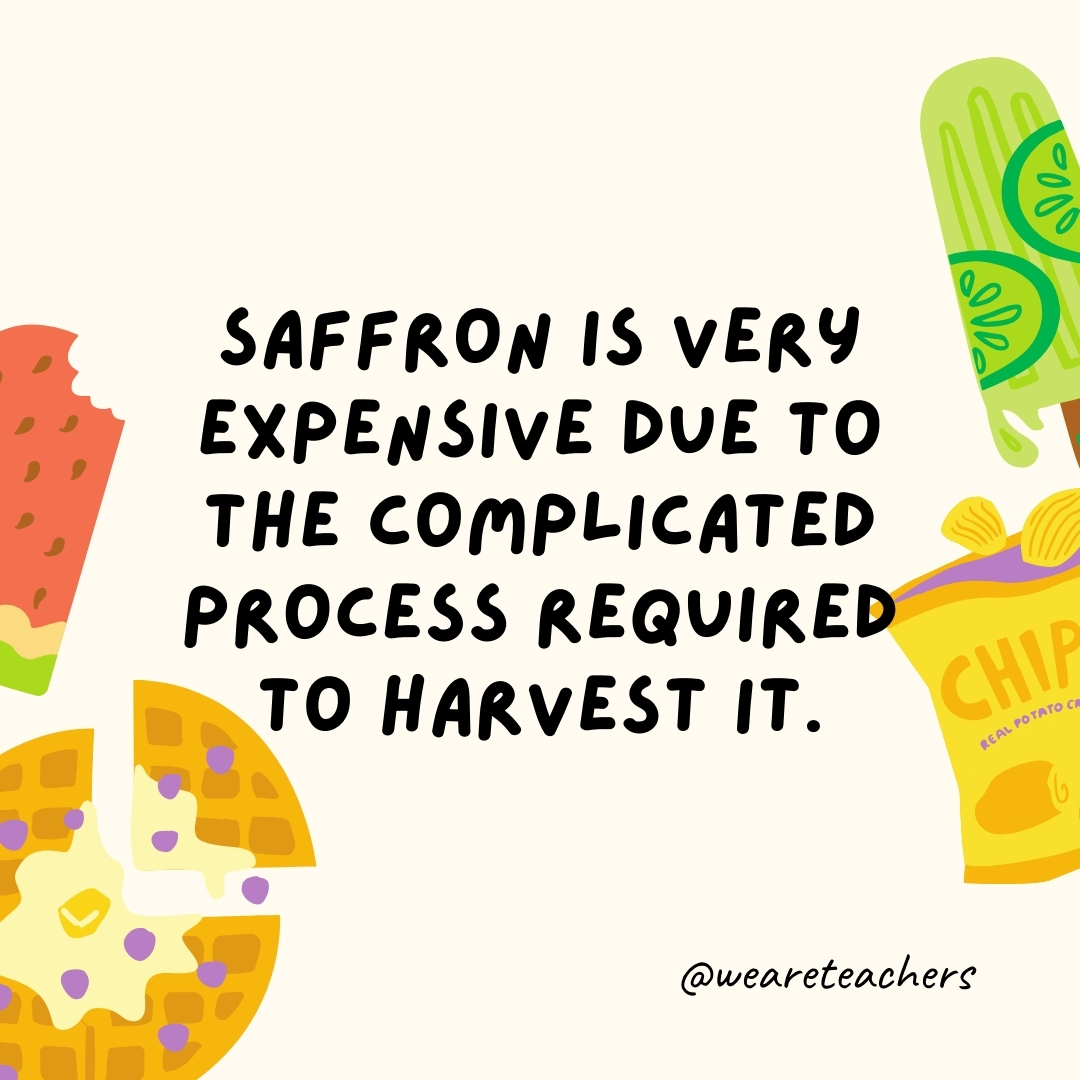
The crocus flower is the source of saffron, the world’s most expensive spice. It takes about 75,000 flowers to produce a single pound of saffron spice.
36. Popcorn is one of the world’s oldest preserved foods.
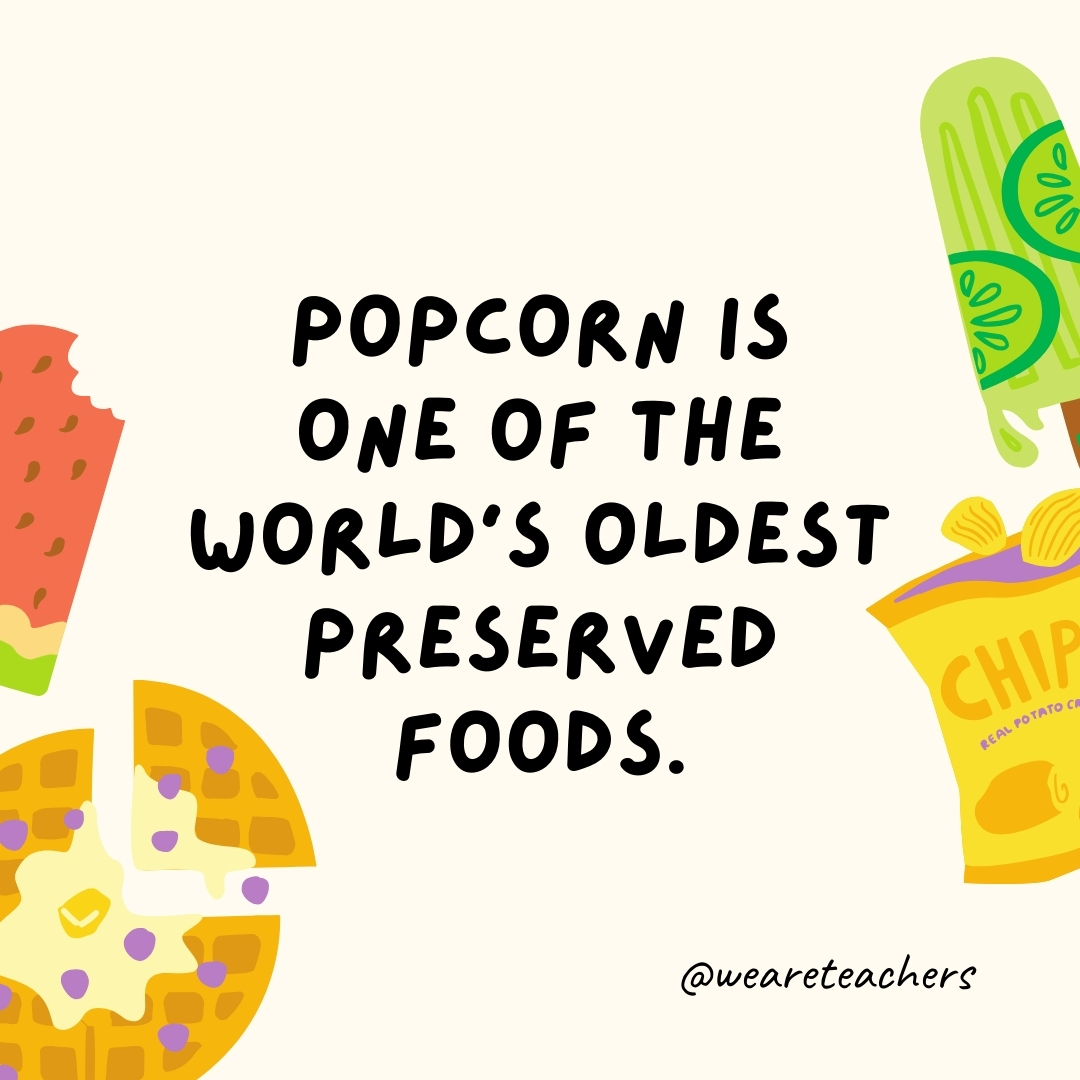
This is one of the oldest fun food facts. Archaeologists discovered remnants of popcorn dating back to over 6,700 years ago.
37. Natural vanilla flavor comes from an orchid.
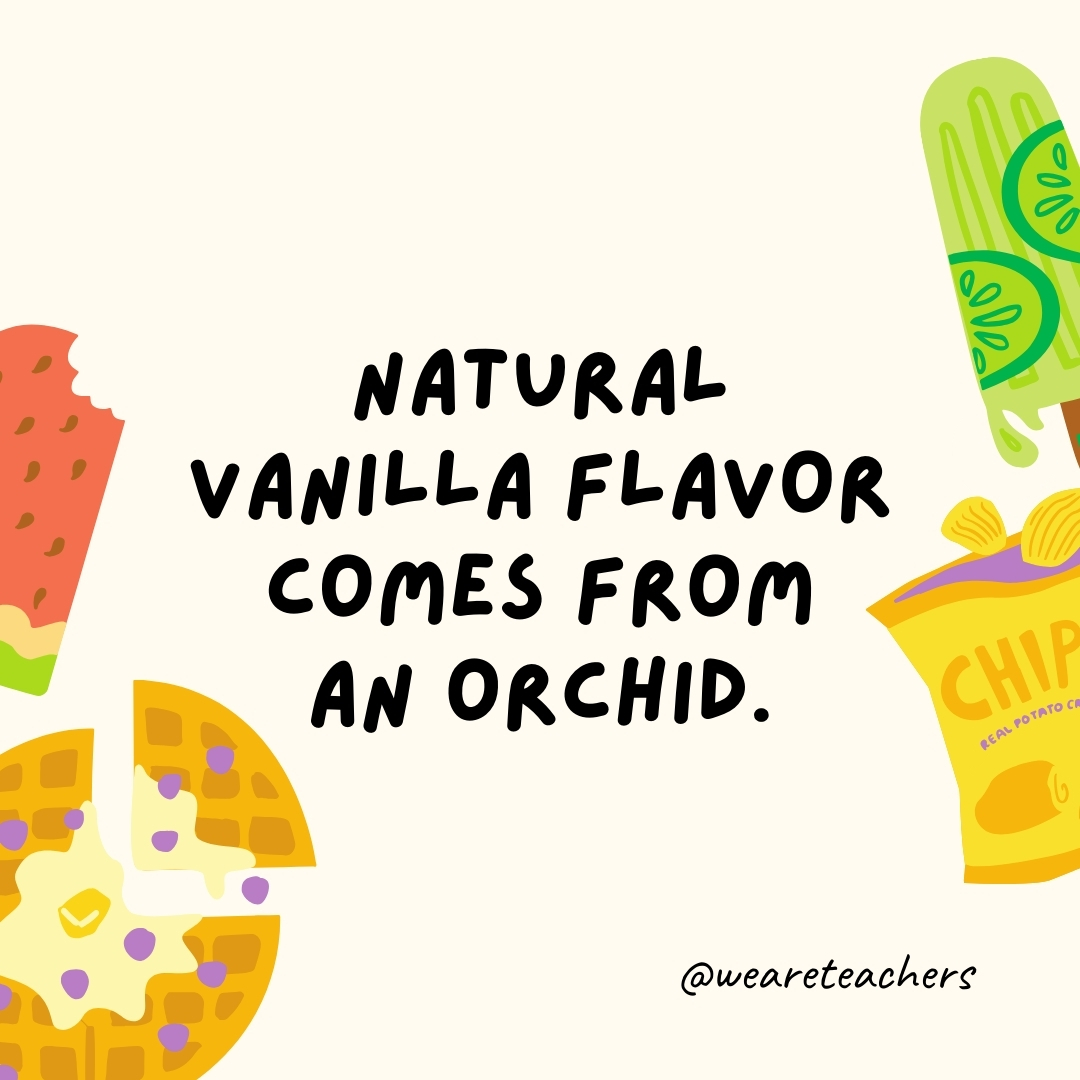
The vanilla pod comes from a type of orchid plant, although much of the vanilla used today is produced synthetically.
Sweet Treats Fun Food Facts
Nearly every kid has a sweet tooth, so they’ll be astonished to learn some fascinating facts about chocolate, candy, and other delicious treats.
38. The cereal Froot Loops all taste the same even though they are different colors.
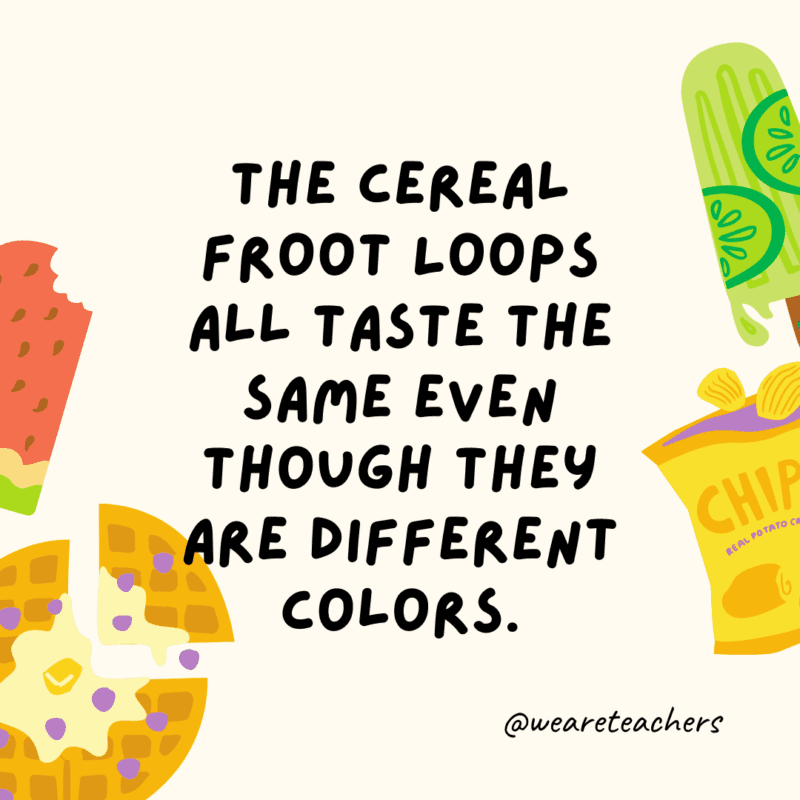
Not only are Froot Loops all the same flavor, but blind tests show that people think they also taste the same as Trix and Fruity Pebbles!
39. Cotton candy was created by a dentist.

Learn more about this yummy invention in this video!
40. M&Ms are named after their creators: Mars & Murrie.
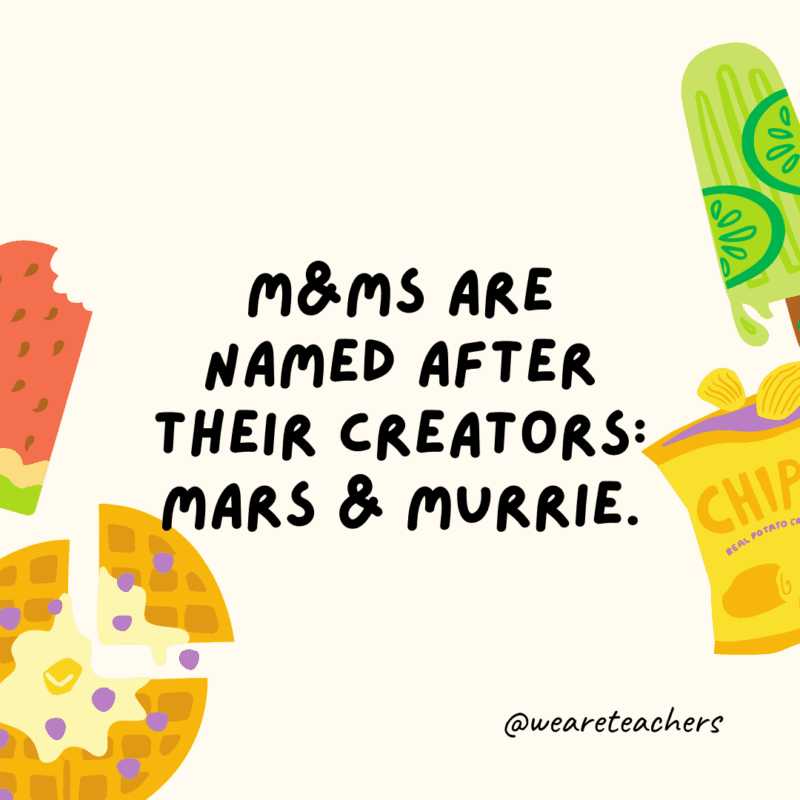
Learn how M&Ms, candies named after their creators, are made in this video from Unwrapped.
41. The filling in Kit Kats is made with crumbs from broken Kit Kat bars.

The Kit Kat rejects all get mashed up together and turned into the wafer paste. See a video of the entire Kit Kat process here.
42. Popsicles were invented accidentally by a child, 11-year-old Frank Epperson.
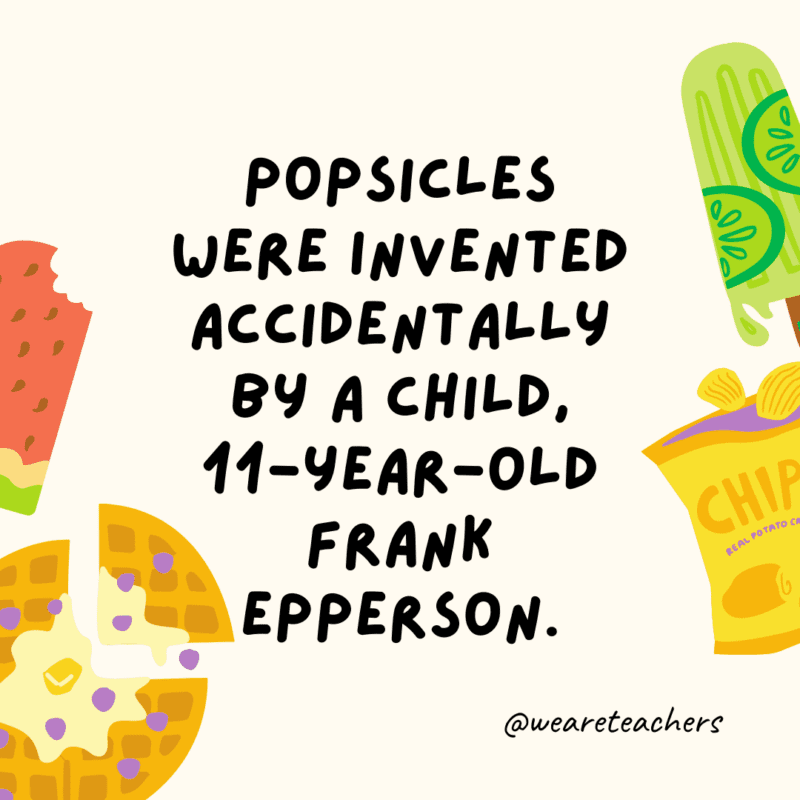
We love a good accidental invention! Check out more invention videos here.
43. Pound cake gets its name from its recipe.
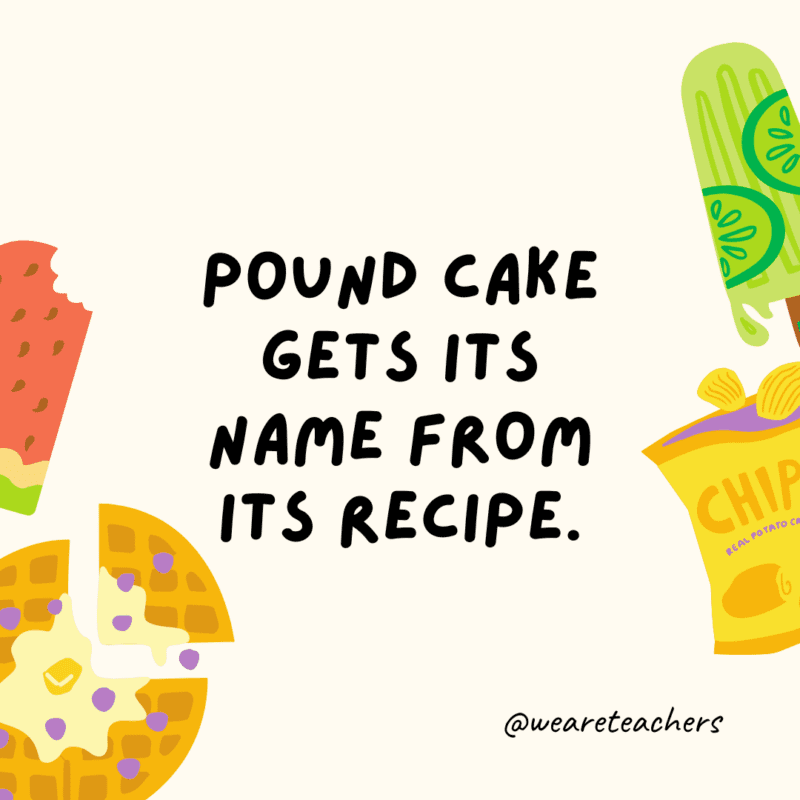
The early recipe for pound cake was super easy to remember: one pound of butter, one pound of sugar, one pound of flour, and one pound of eggs!
44. Three Musketeers candy bars used to have three flavors.

The famous Three Musketeers candy bar originally had vanilla, strawberry, and chocolate flavors in one! However, during World War II, they changed to only chocolate due to rations.
45. Ancient civilizations used chocolate as currency.
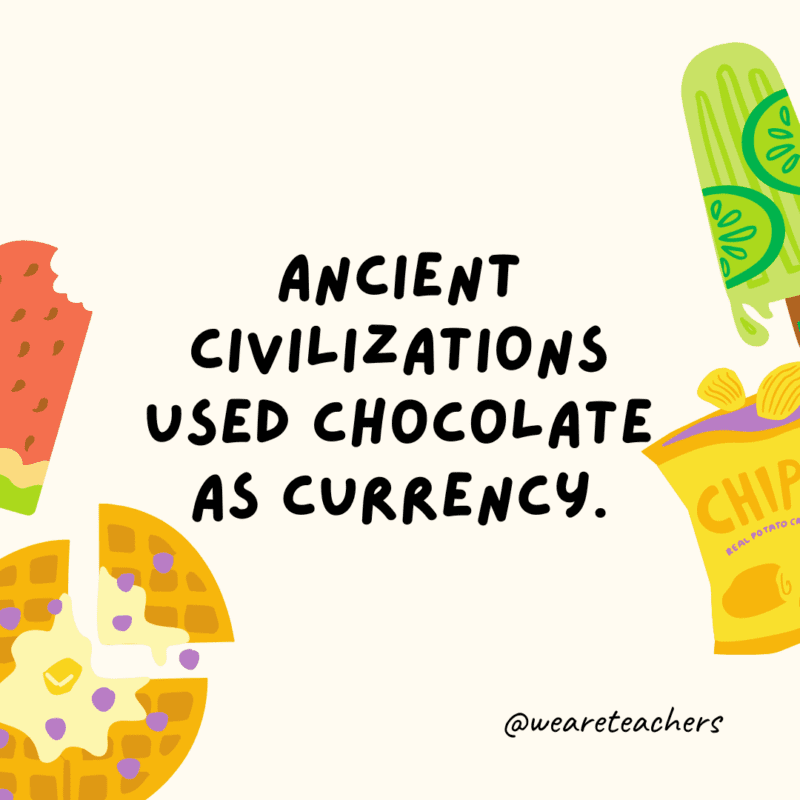
A system of money in the Mayan civilization used cocoa beans.
46. There’s no cream inside Twinkies.

All of that fluffy, creamy goodness is actually a mixture containing vegetable shortening!
47. Jam and jelly are different.

How can you tell them apart? Jam is chunky because it’s made with pieces of fruit. Jelly is smoother because it’s made with fruit juice.
48. Brown sugar and white sugar come from the same sources.

It might have a better reputation, but brown sugar is no less refined than white sugar. Both are generally made from sugarcane or sugar beets. The only real difference? Some of the molasses lost during the refining process gets added back, and their nutritional elements are slightly different.
49. Fortune cookies aren’t Chinese.
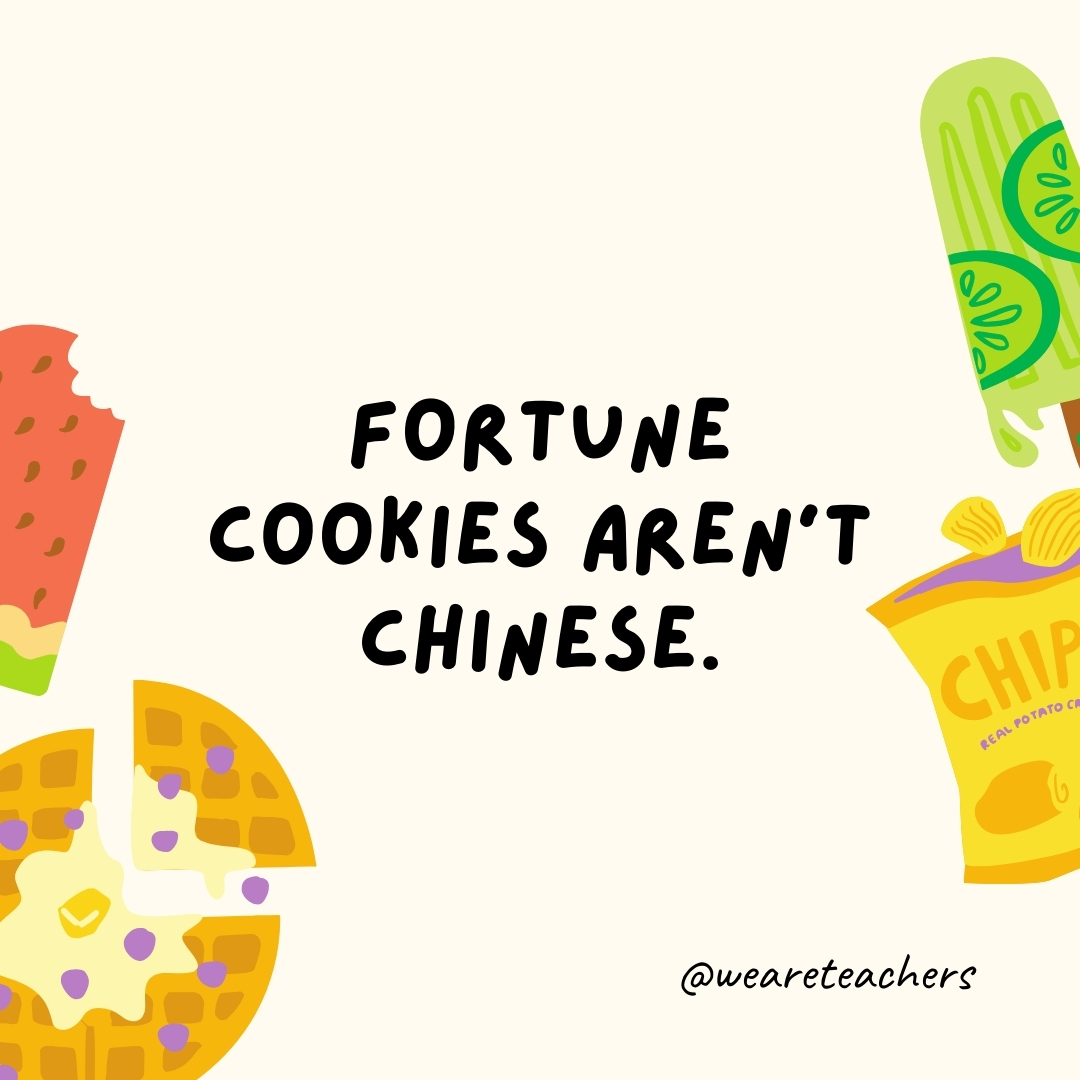
Modern fortune cookies were actually invented in America and are based on a traditional Japanese cracker.
50. Artificial banana flavor is based on an extinct banana.
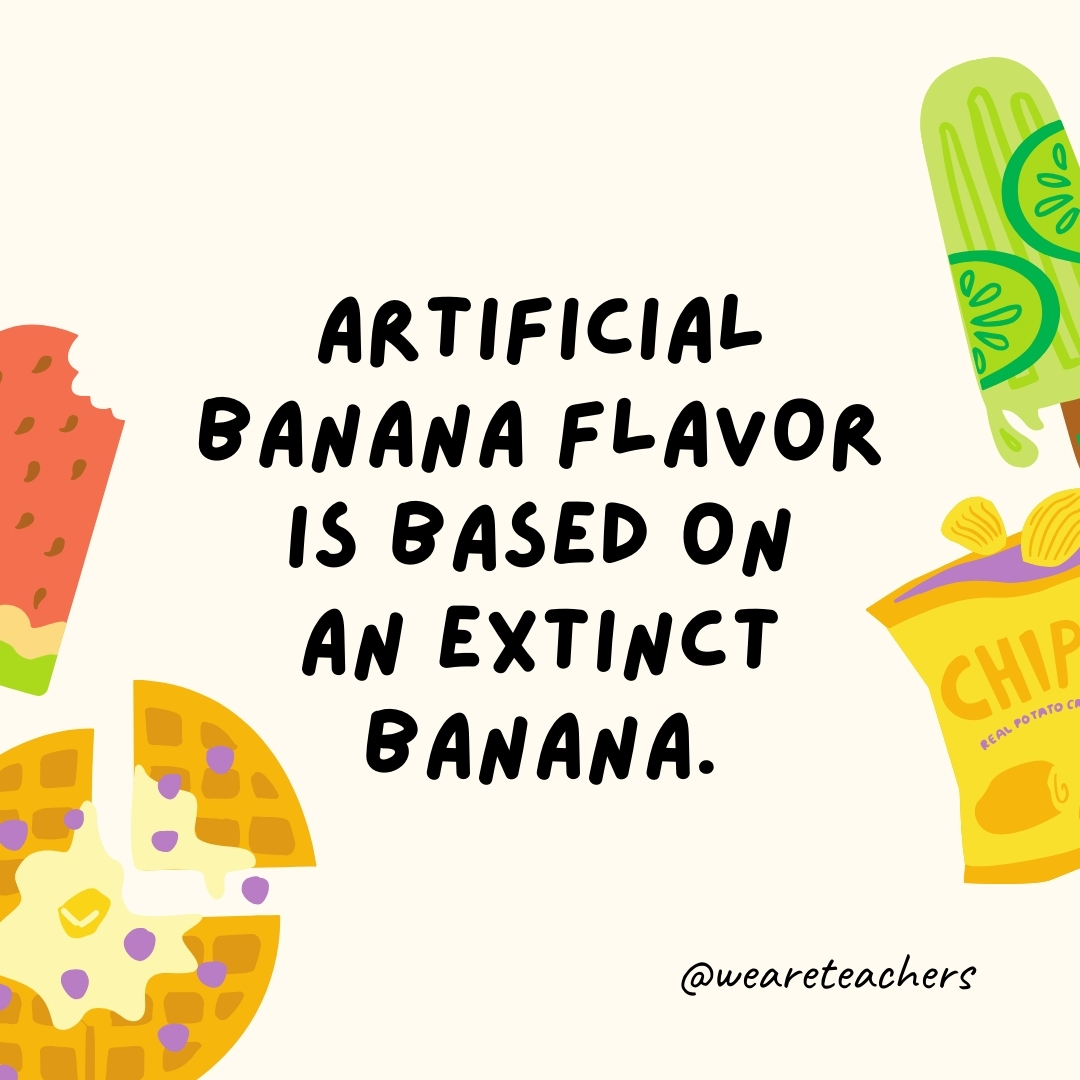
The artificial banana flavor in many snacks and candies is based on a type of banana that was wiped out by a plague in the 1950s called the Gros Michel. OK, to be fully transparent, while this is a widely held belief, this is one of the many fun food facts that has been debated.
51. Chocolate can be deadly to dogs.
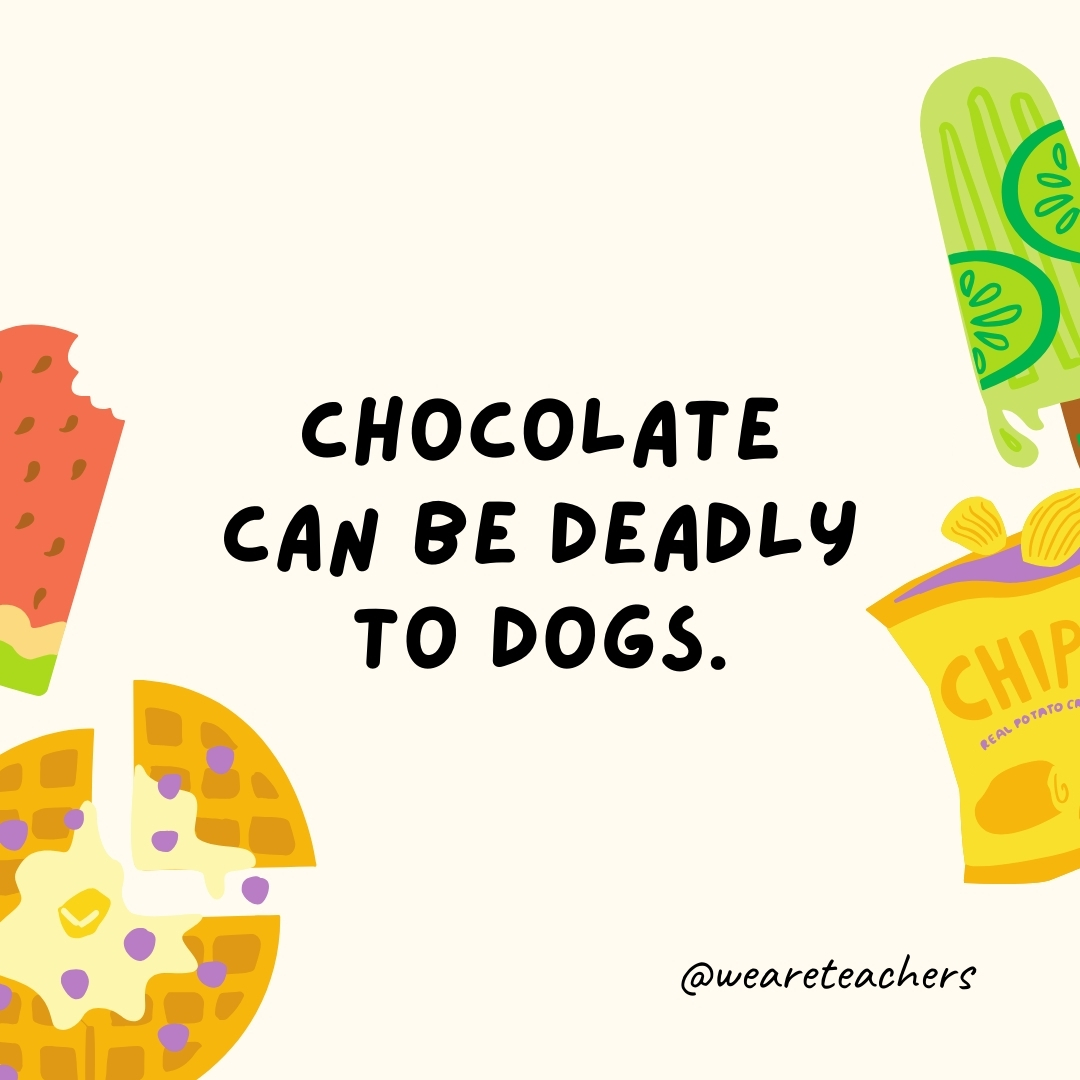
Chocolate contains theobromine, which is toxic to dogs in large quantities.
52. Honey never spoils.
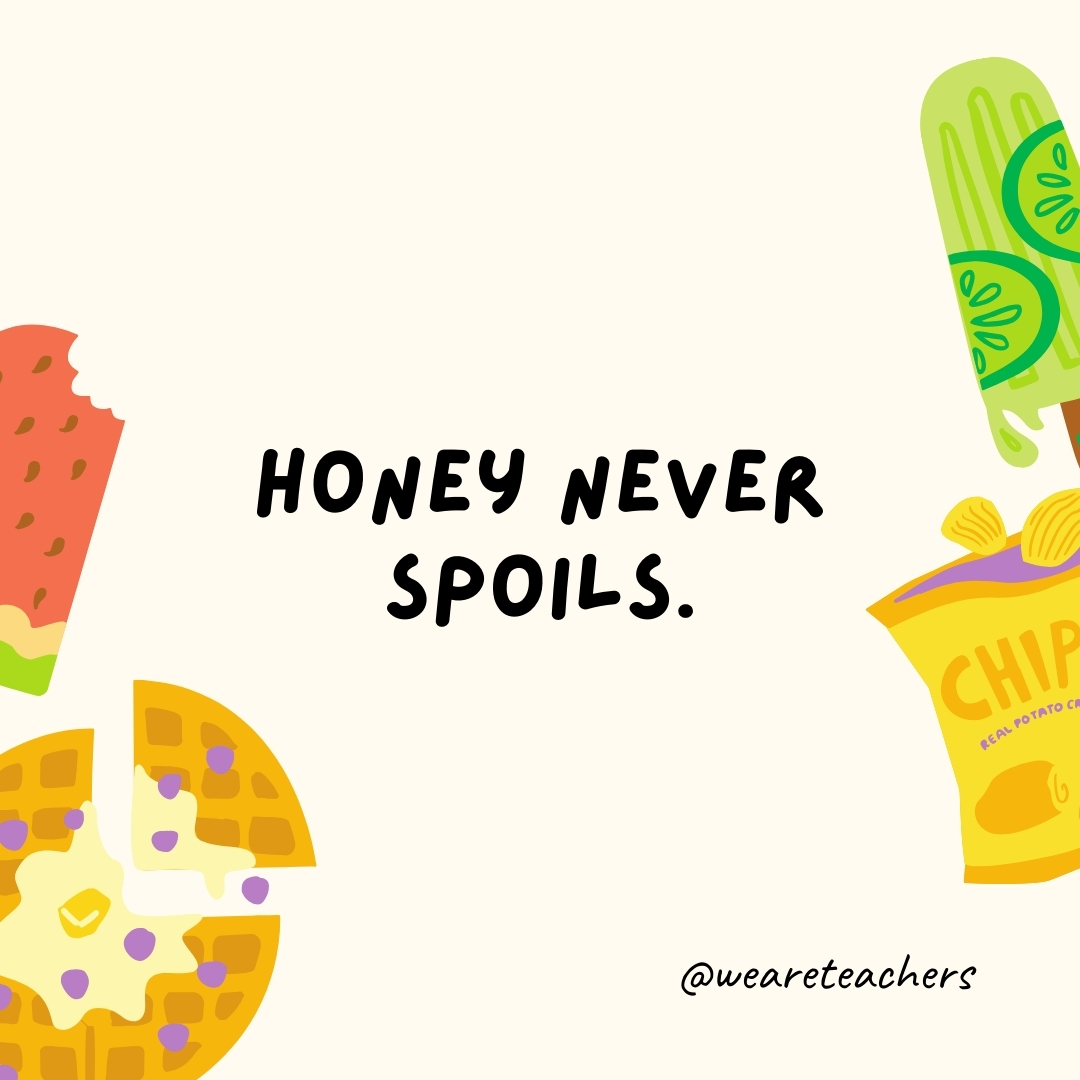
Archaeologists have found pots of honey in ancient Egyptian tombs that are still perfectly edible.
53. The first chocolate bar was made in 1847.

Joseph Fry and his son discovered a method to create a moldable paste by mixing some cocoa butter back into the chocolate along with sugar.
54. White chocolate isn’t technically chocolate.
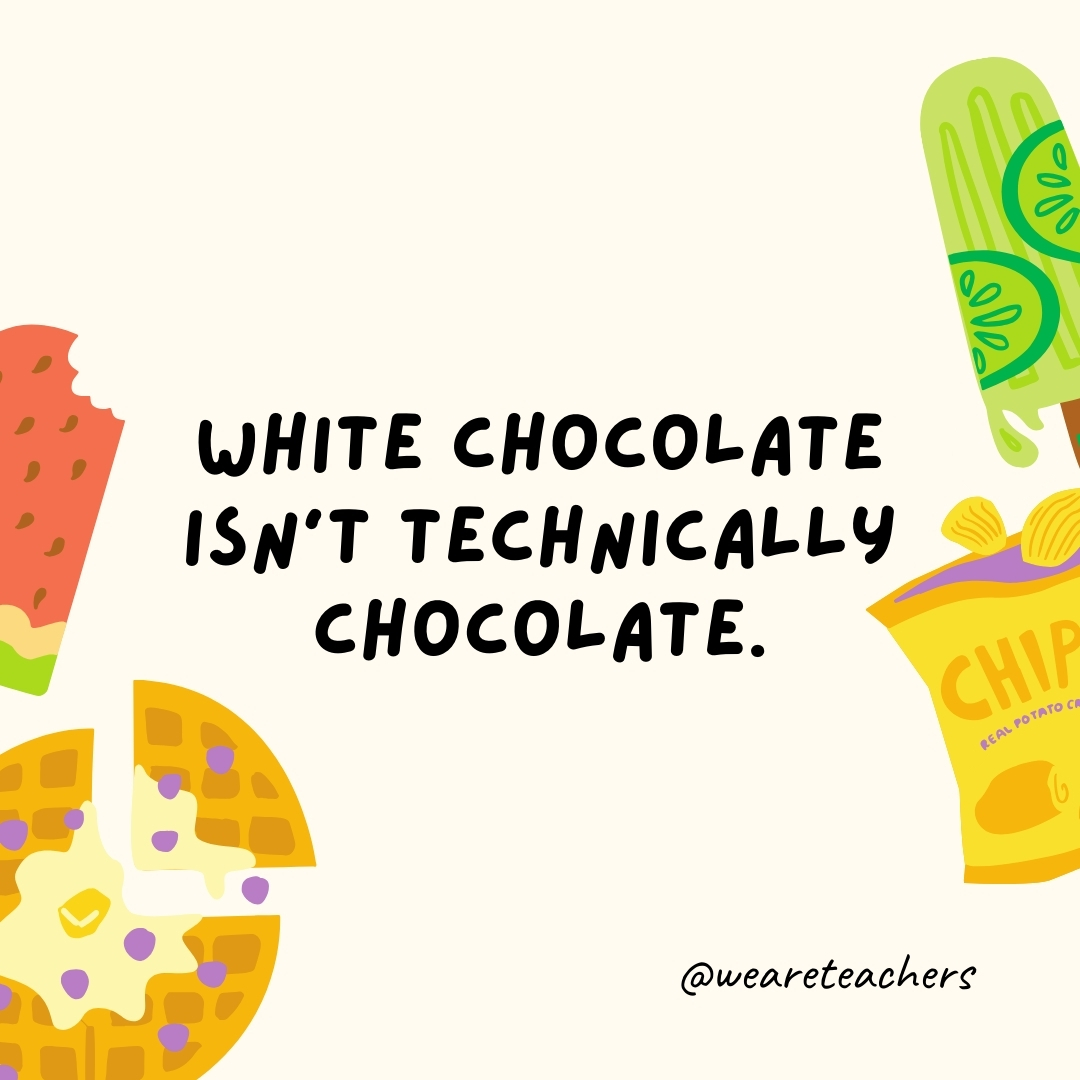
As it contains no cocoa solids or cocoa liquor, white chocolate can’t technically be called chocolate.
55. Dark chocolate has health benefits.
When you really need a chocolate fix, choose dark chocolate when you can. It has high amounts of fiber, iron, magnesium, copper, and other nutrients. It’s also loaded with antioxidants and could help decrease high blood pressure. Just remember that dark chocolate is also high in calories and fat!
Gross but Fun Food Facts
Let’s face it: Not all fun food facts are totally tasty. Sometimes food can be downright gross!
56. Rotten eggs float.

Worried that your eggs have gone bad? There’s an easy way to find out. Just put them in a bowl of cold water and if they float, throw them out!
57. Honey is basically bee vomit. Forager bees regurgitate it.
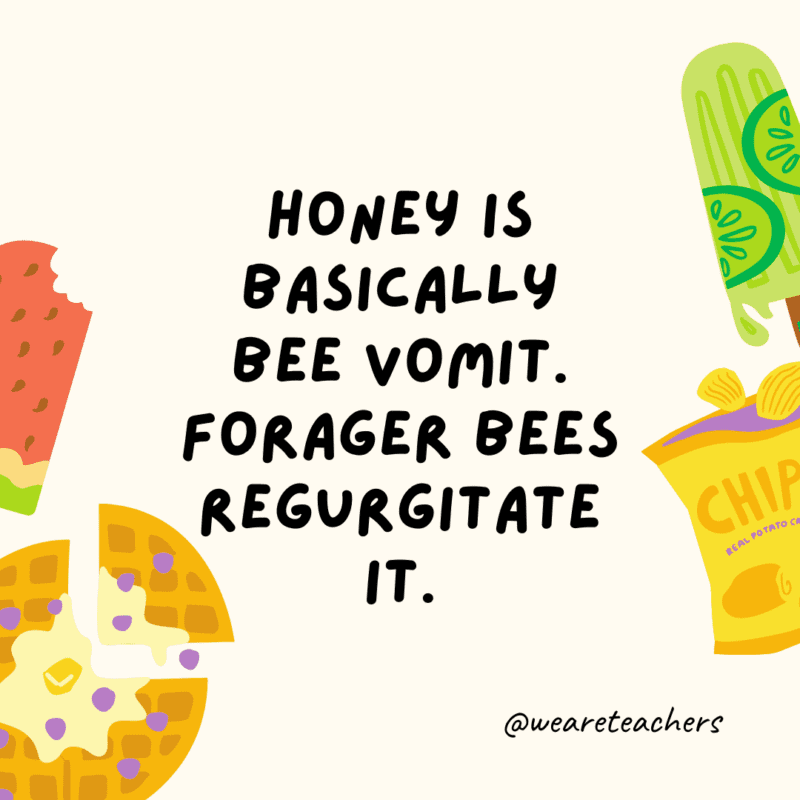
If you’re looking for fun food facts that are also gross, add this to your list. So, while it’s fair that some argue that it’s not, and some argue that it is, the truth is that it’s somewhere in the middle. Watch the whole process of how bees make honey in this video.
58. Berries that harbor up to 4 larvae per 500 grams are safe to eat per the FDA.
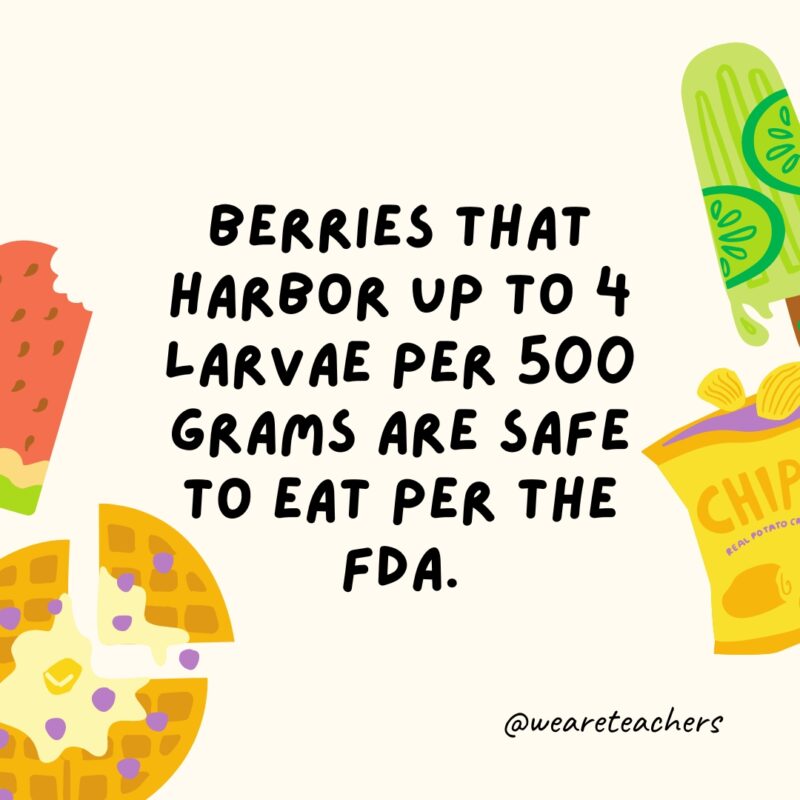
The consensus is that a tiny worm isn’t going to hurt us (but it’s still kinda gross!).
59. The average jar of peanut butter may contain 4 or more rodent hairs.

Looking for more gross fun food facts? The FDA allows one or more rodent hairs per 3.5 ounces (100 grams) of peanut butter! Also, did you know that peanut butter can be turned into diamonds? Learn more in this video from KiwiCo.
60. The dye used for some red candy, cake, and drinks is made from the crushed bodies of beetles.

The red food dye called carminic acid that’s used in some foods is actually made from the crushed bodies of Dactylopius coccus, a type of beetle. Some companies, including Starbucks, have discontinued using the dye.
61. A burger could contain meat from 100 different cows.

The ground beef used at fast-food restaurants and grocery stores doesn’t come from a single animal. Each package is made from a collection of meat from different cows.
62. Your food may contain some insects.
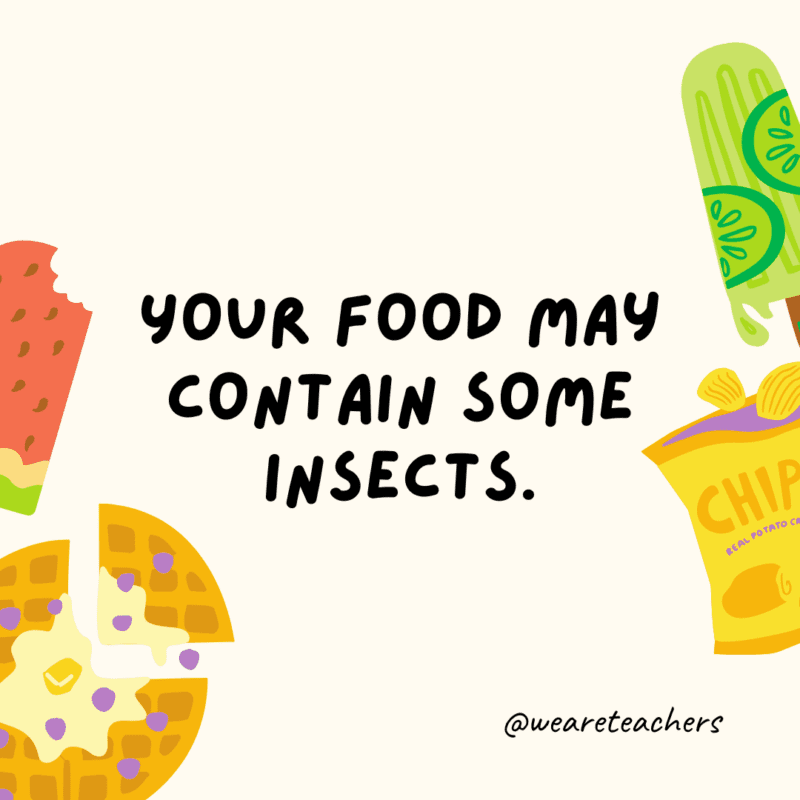
Did you know that the FDA allows some traces of bugs in the food we consume? You can have up to 30 insects per 100 grams of peanut butter, for example!
63. Gummies are shiny because of car wax.

These fruit-flavored snacks get their glossy sheen from a coating of carnauba wax, the same type of wax used on cars.
64. McDonald’s once made bubblegum-flavored broccoli.
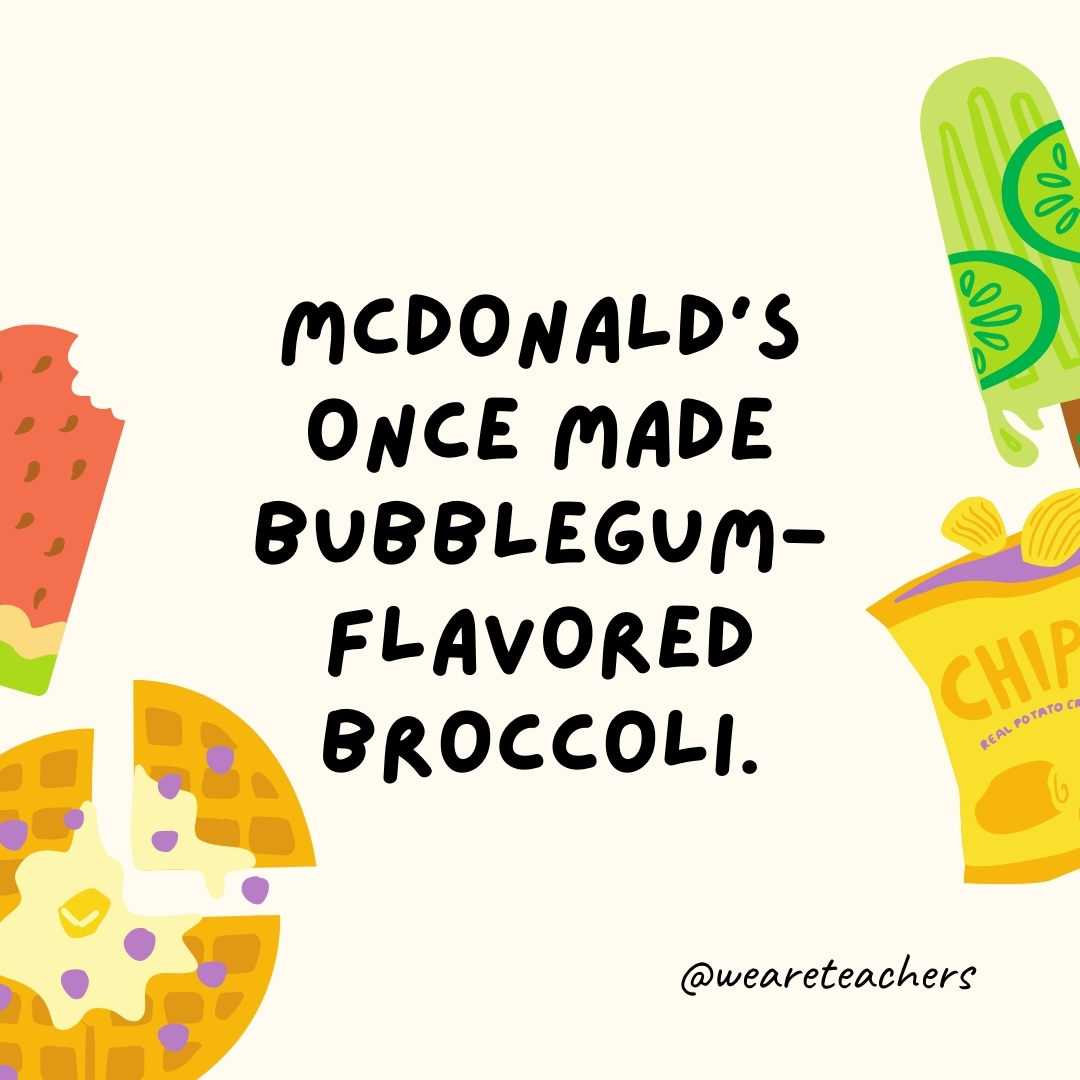
This was an attempt to make kids eat more healthily. However, the unusual flavor combination didn’t last long on the market. This is one of those fun food facts that makes you go hmmm.
65. Farmed salmon is dyed pink.
Salmon grown in captivity don’t eat the same foods as their wild-caught cousins, including shrimp, krill, and algae, that give their flesh a naturally pink-orange color. To achieve the color customers expect, salmon farmers add carotenoids to their feed. These carotenoids might be derived from ground-up crustacean shells or made synthetically.
Savory Fun Food Facts
If you reach for salty snacks over sweet, these food facts are for you!
66. You can buy a $12,000 pizza.

Three Italian chefs will spend 72 hours in your home making a pizza topped with lobster, mozzarella, and three types of caviar! Learn more about this pricey slice.
67. Ketchup was once used as a medicine.
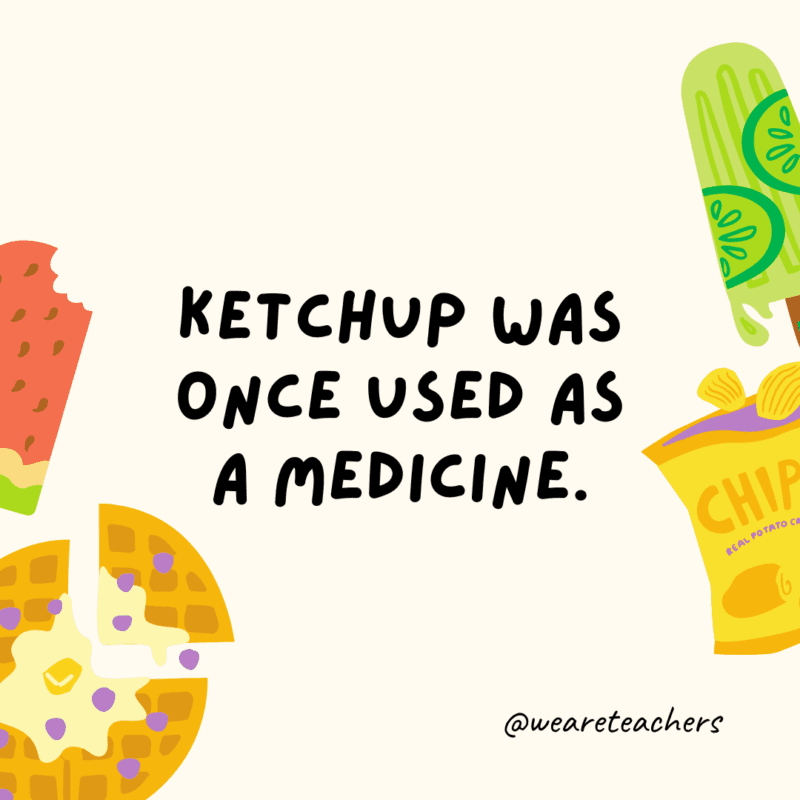
In the 1830s, a doctor created a ketchup recipe that treats indigestion and diarrhea.
68. Spam wasn’t invented in Hawaii.

While Spam is very popular in the Aloha State, it was actually created in Minnesota!
69. McDonald’s sells more than 2 billion hamburgers every year.
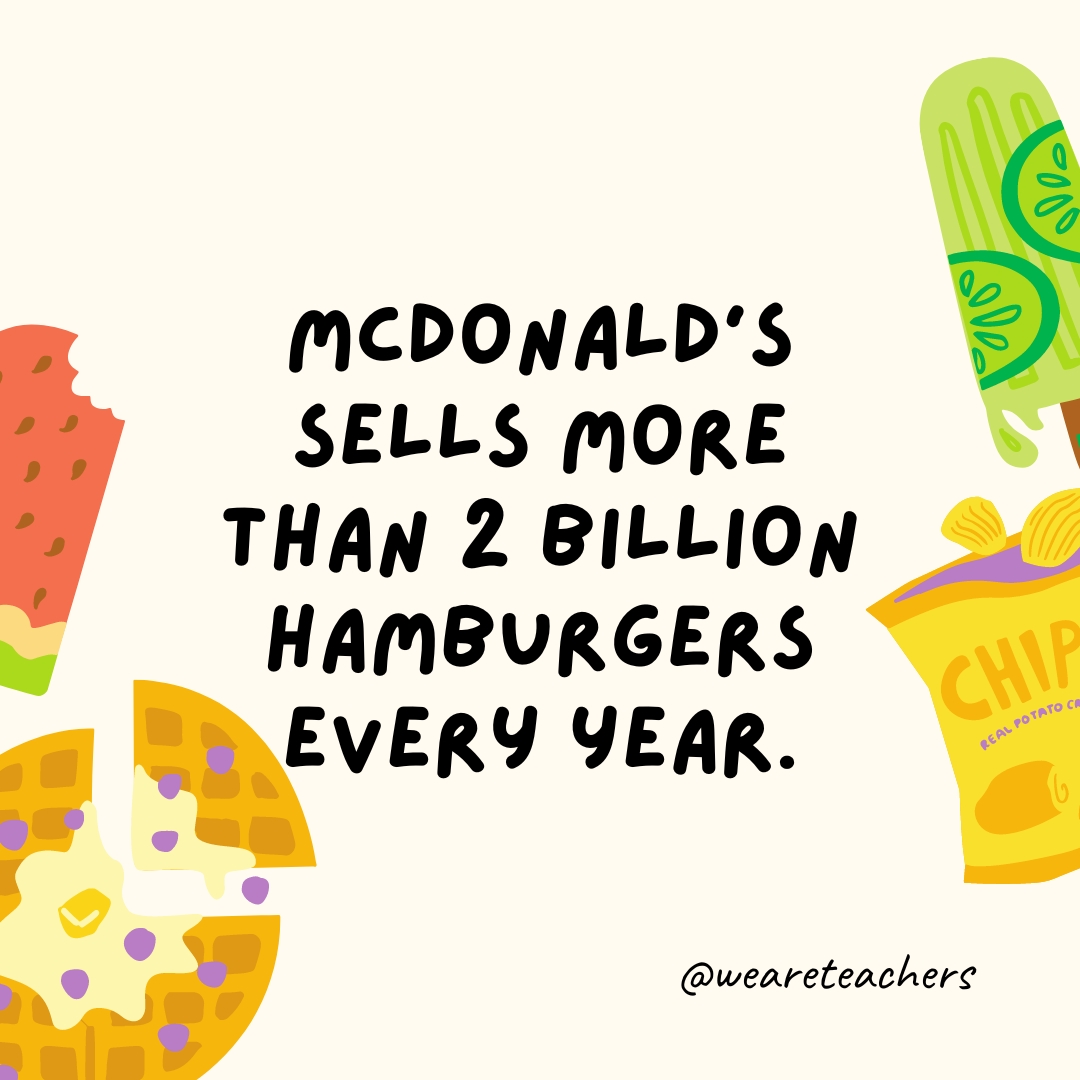
This means they sell about 6.48 million hamburgers every day—and more than 75 burgers per second!
70. Margherita pizza is named after a queen.

During a visit to Naples, King Umberto I and Queen Margherita requested pizza. The queen loved the mozzarella pizza so much that they named it after her!
71. Thomas Jefferson popularized mac and cheese in America.
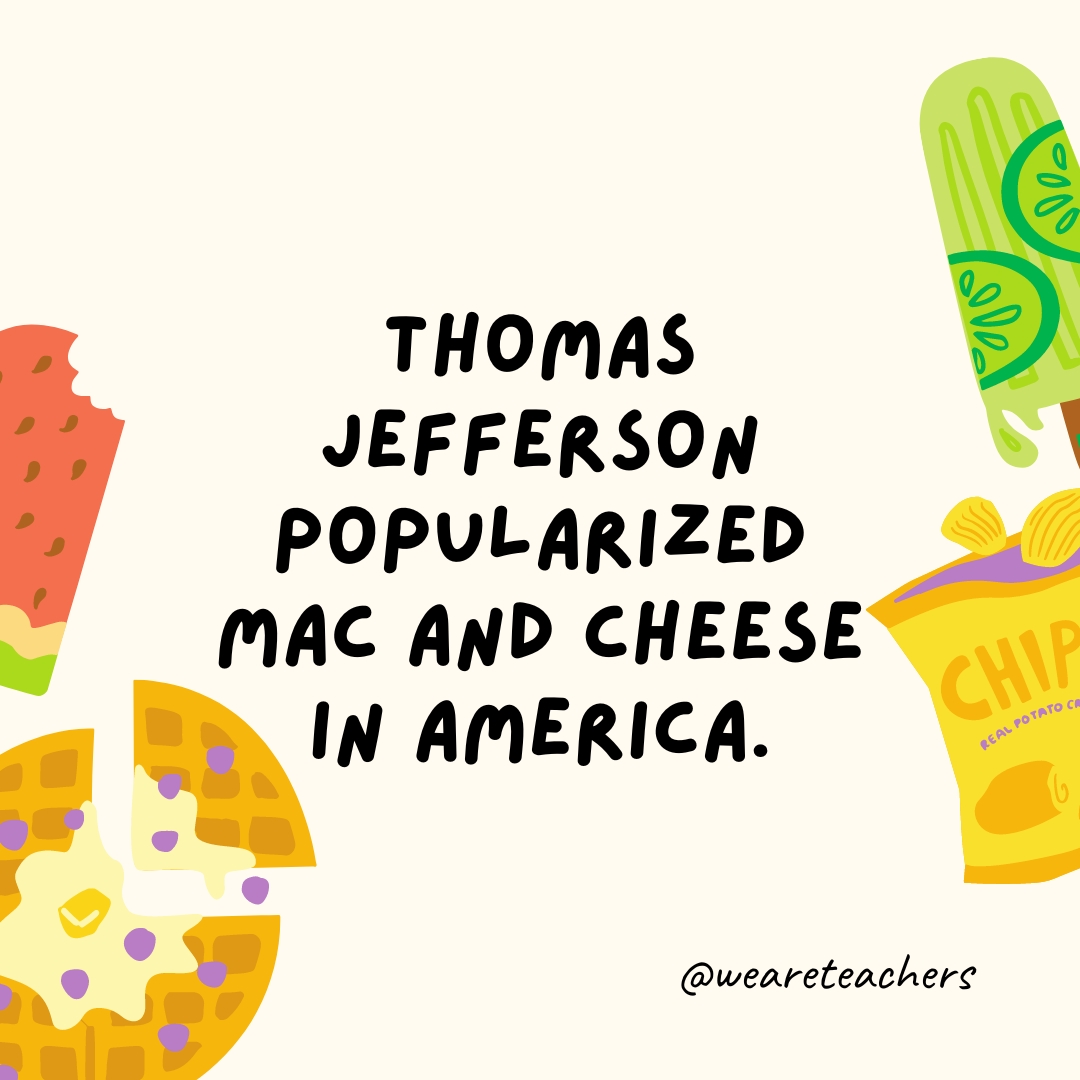
After living abroad in France, America’s third president loved the dish so much that he designed the first macaroni-making machine in the United States.
72. Crackers have holes for a reason.
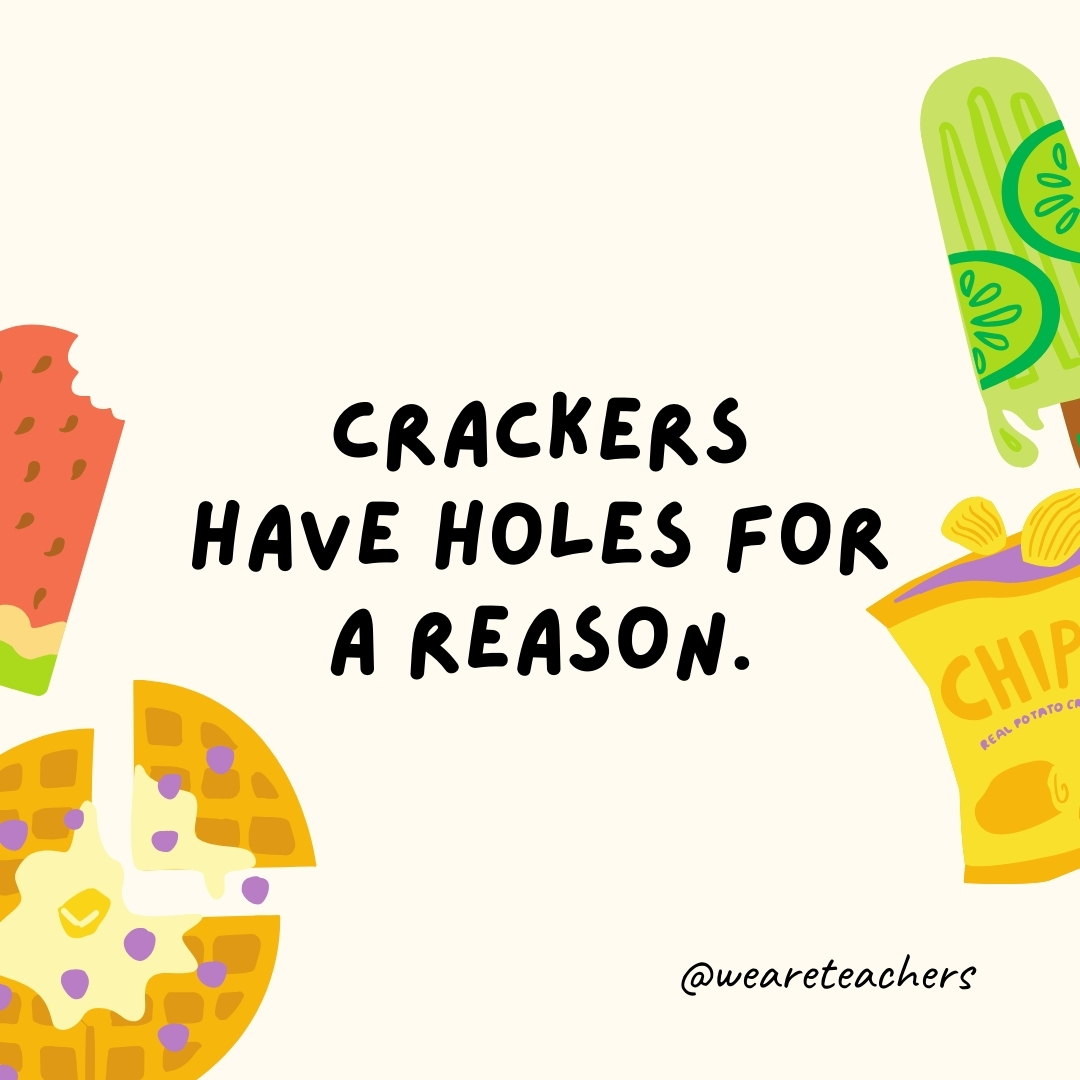
The holes in crackers are not just for decoration. They’re there to stop air bubbles from ruining the product during baking.
73. Hawaiian pizza didn’t come from Hawaii.
It didn’t come from Italy either, or even New York City. Instead, most sources trace the popularity of a pizza made with pineapple and ham to a Greek Canadian. Sam Panopoulos and his brothers owned a restaurant in Ontario, where they introduced Hawaiian pizza in the 1960s. Love it or hate it, this popular topping combo has been around for 60+ years!
74. There are over 350 shapes of pasta.
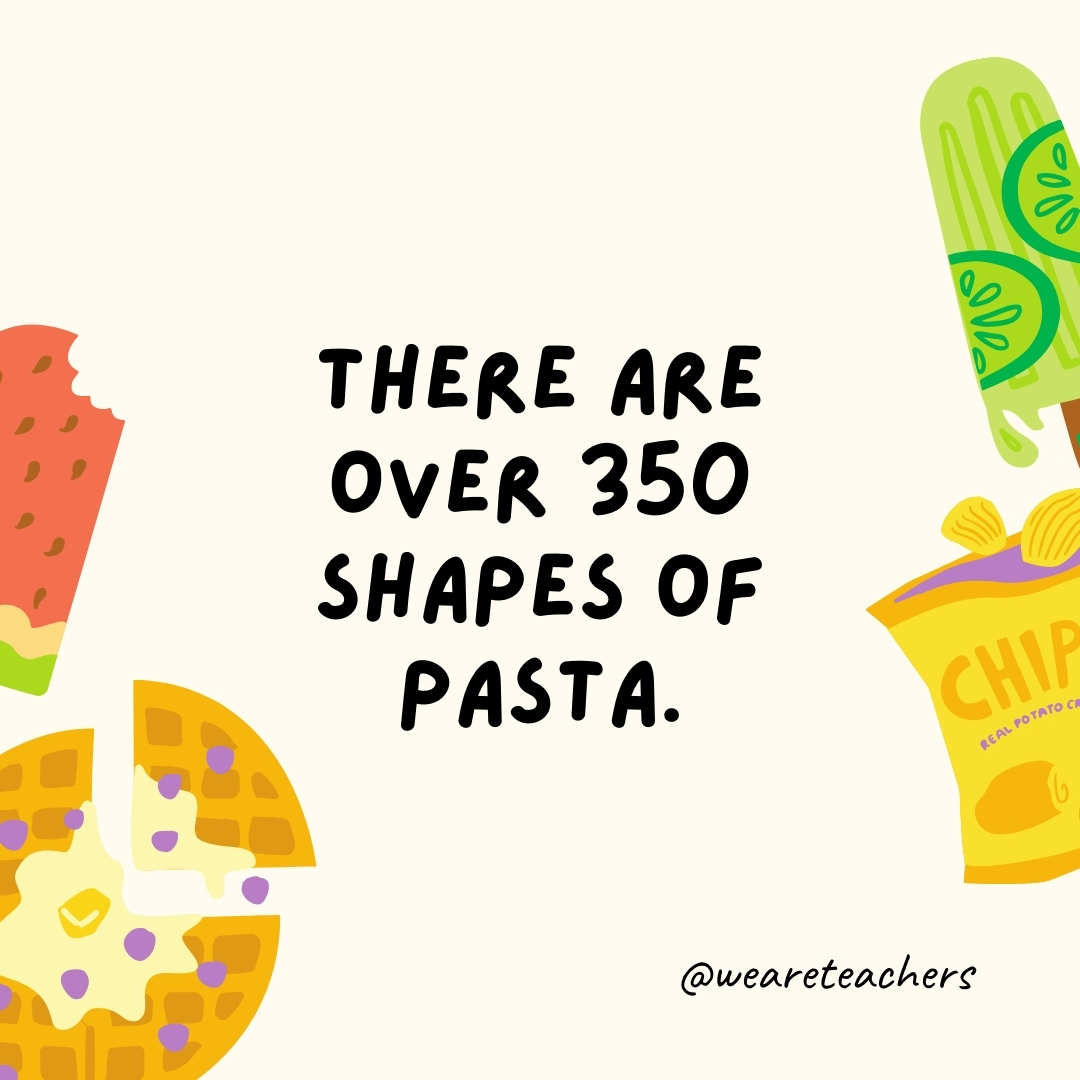
In Italy, the variety of pasta shapes is vast, each designed to hold sauce in a different way.
75. Mustard is one of the world’s oldest condiments.
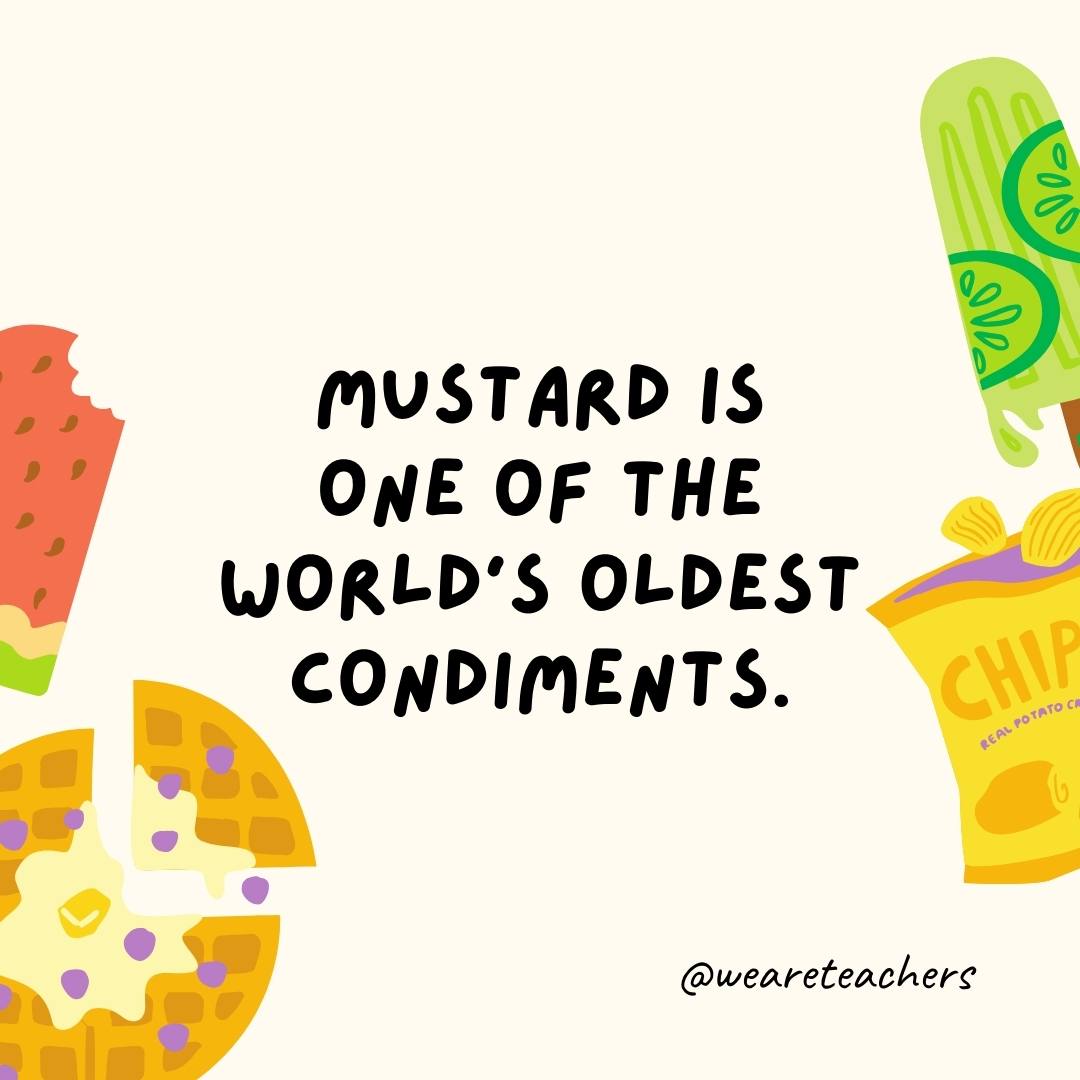
Mustard dates back to early Roman cooks who mixed unfermented wine or grape juice, known as “must,” with ground mustard seeds to make “mustum ardens,” or “burning must.”
76. Hot dogs were first sold at baseball games in 1893.
The vendors who sell them carry them around in bins averaging a whopping 40 pounds! Also, many people consider it bad “etiquette” (or bad taste) to put ketchup on a hot dog.
Surprising Food Facts
These facts are the ones that will blow your students’ minds, from the mind-bogglingly huge amount of sandwiches we eat every day to the fact that eating hot peppers actually cools you down.
77. Food tastes different in an airplane.

While flying, you may have noticed that some flavors don’t taste the same as they do when you’re on the ground. That’s because altitude changes your body chemistry and decreases your taste sensitivity.
78. Tonic water glows in the dark.

Tonic water contains quinine. This chemical component causes it to fluoresce, or glow, under certain light. Want to try it? Here’s a cool STEM activity for the classroom!
79. Almost half of American adults eat a sandwich every day.

Incredibly, a study found that almost half of American adults eat at least one sandwich every day. Wow!
80. An astronaut smuggled a corned beef sandwich into space.

Yup, corned beef has been to space! In 1965, pilot John Young thought he might get hungry as he spent six hours orbiting the earth. When Young took out his sandwich, though, things didn’t go well. In zero gravity, it started to crumble, forcing him to quickly gather all the pieces before they could damage the spacecraft.
81. Mageirocophobia is the fear of cooking.
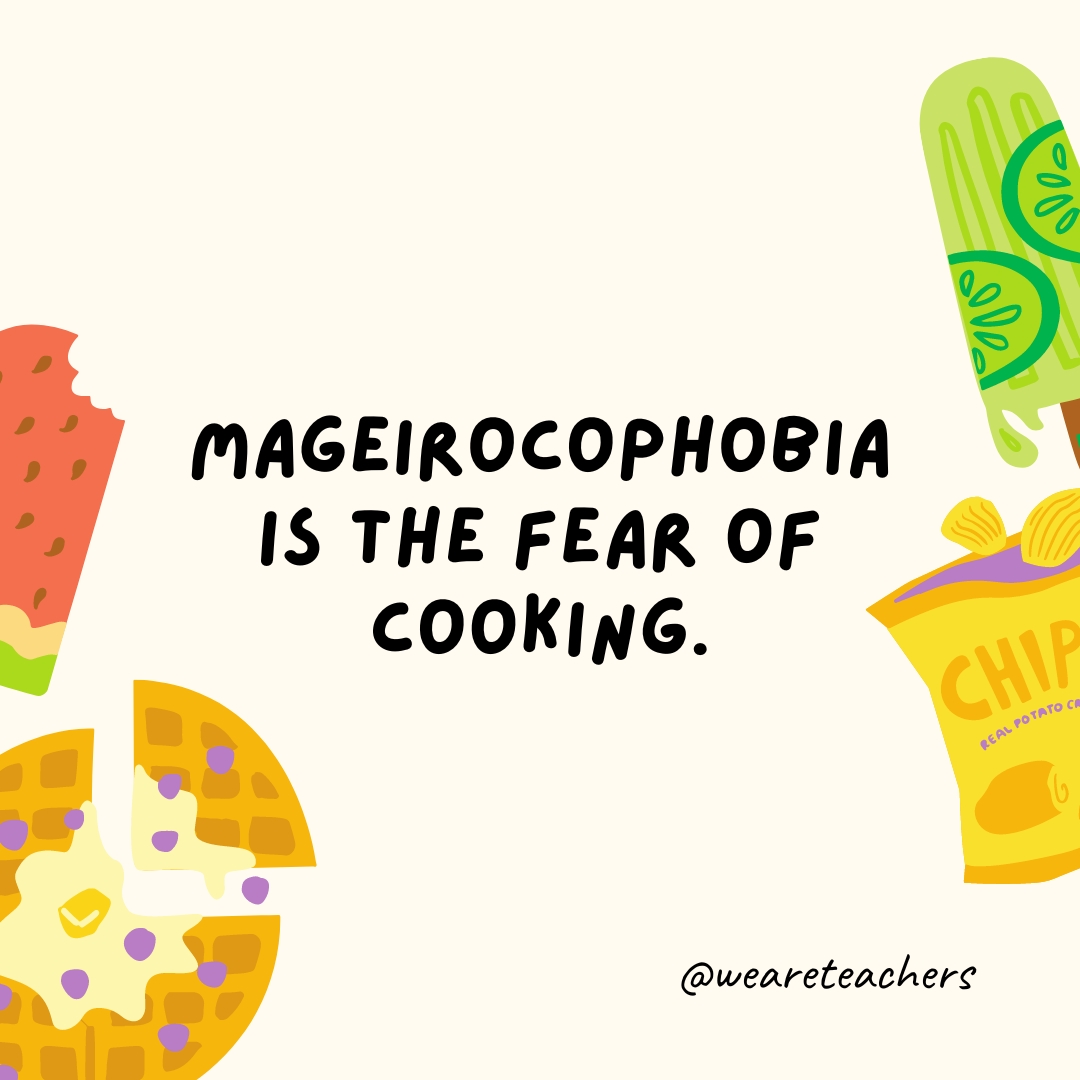
Intense anxiety characterizes the condition, which may stem from a fear of making mistakes.
82. Cheese is the most often stolen food in the world.
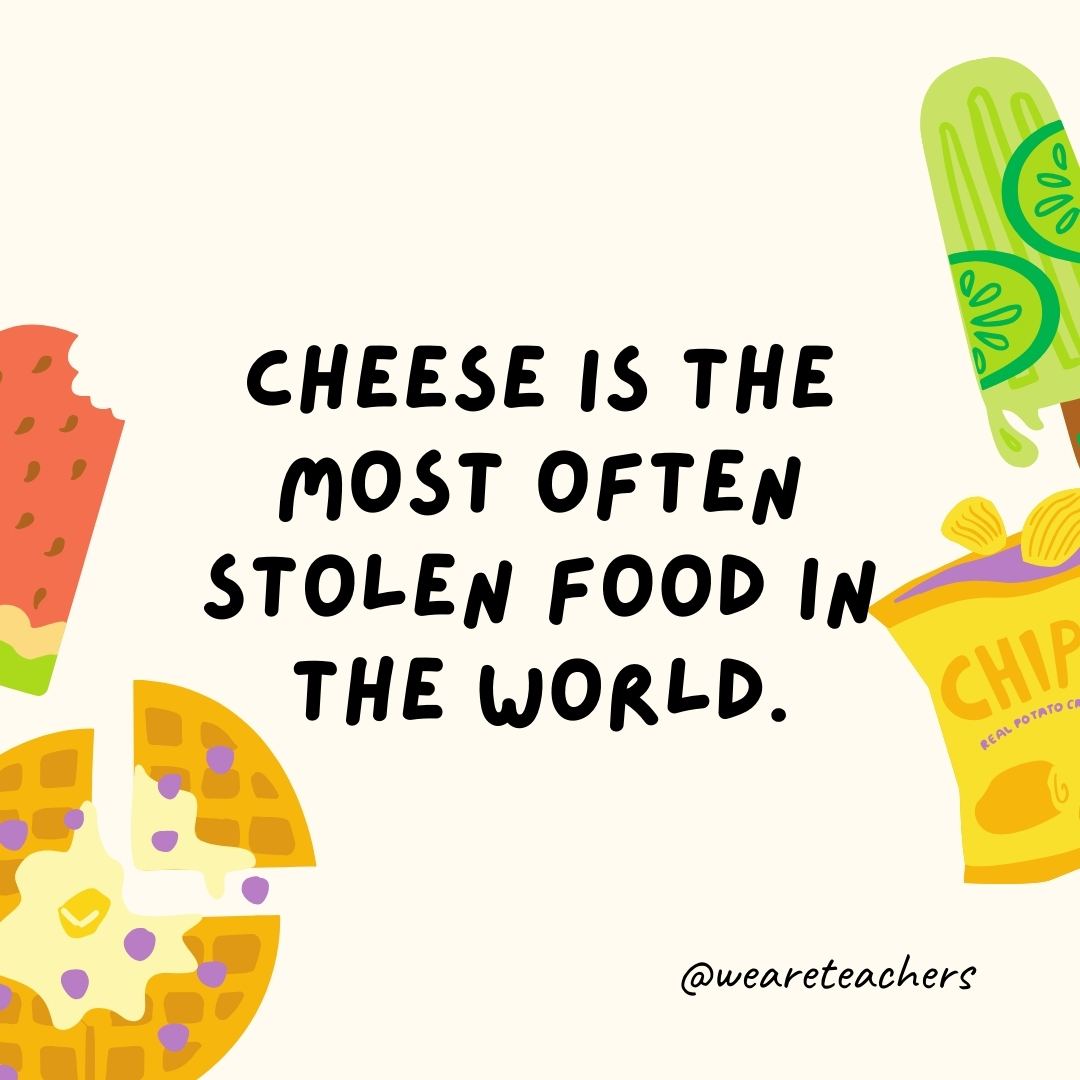
According to the Center for Retail Research in Britain, an astonishing 4% of the world’s cheese ends up stolen.
83. Eating hot peppers cools you down.
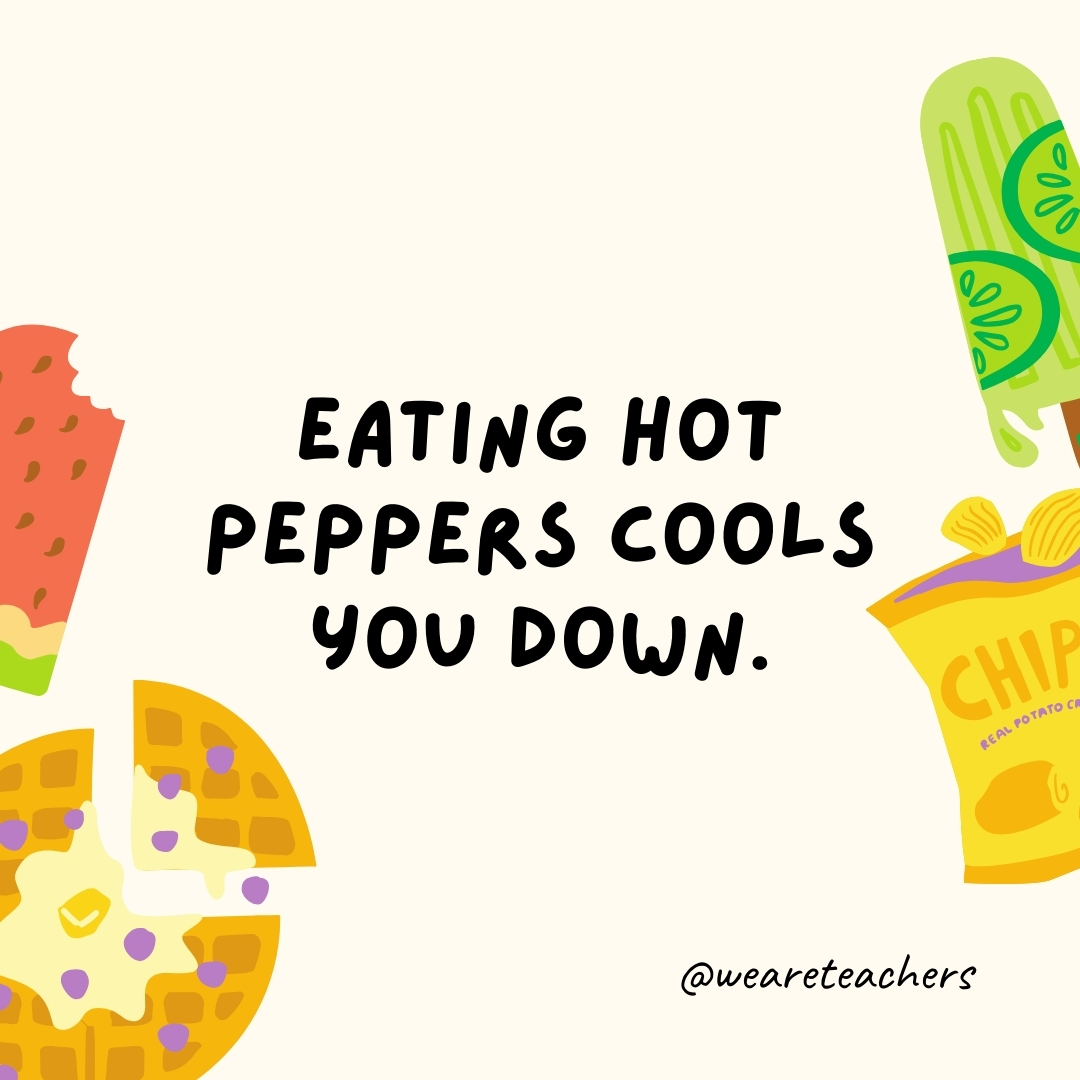
Eating spicy food increases perspiration, which cools the body down, making it a common ingredient in hot countries.
84. Eating competitively is a sport.
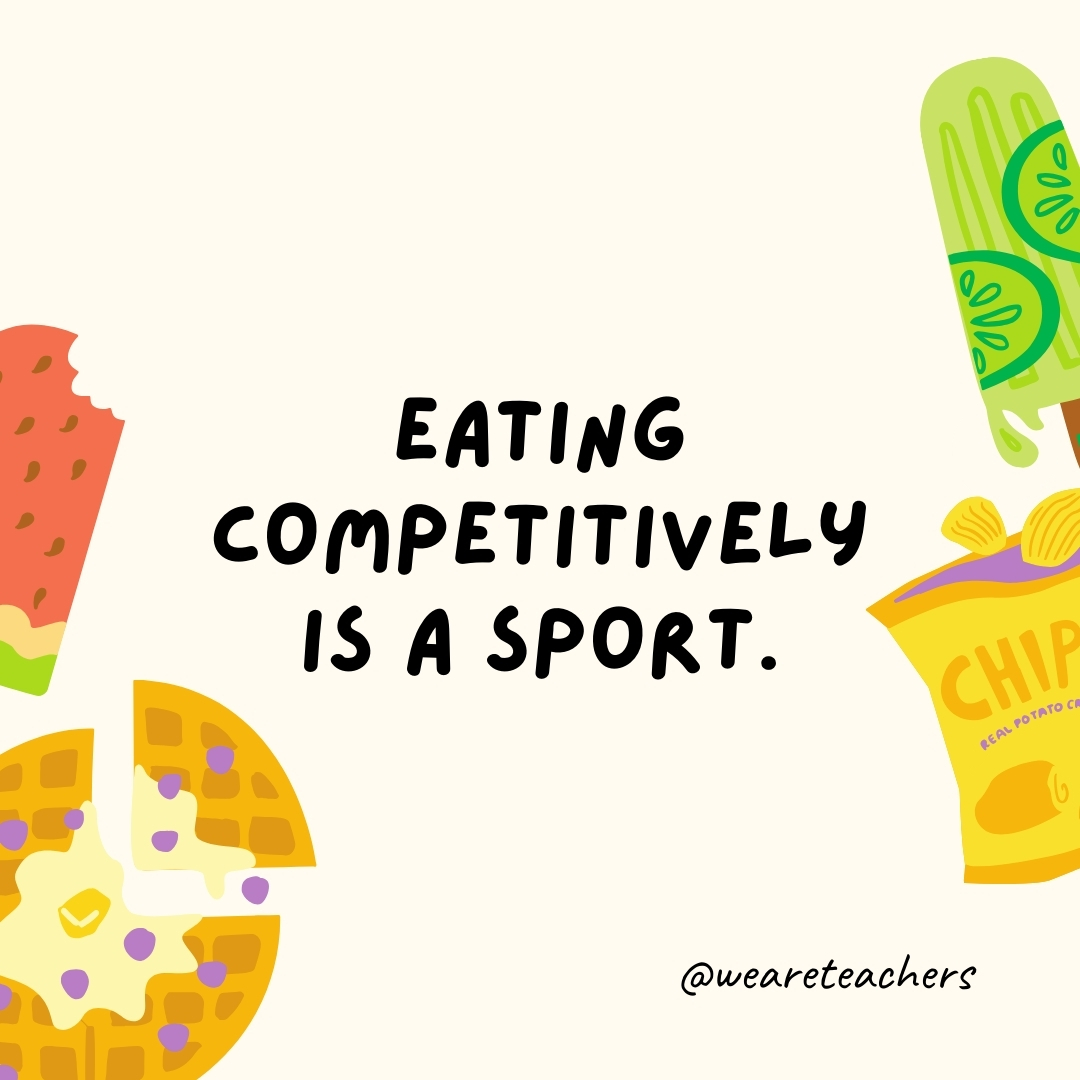
Major League Eating (MLE) is a professional competitive eating organization that holds over 80 events annually.
85. Wine is older than recorded history.

Archaeologists have discovered wine production facilities that are over 9,000 years old.
86. Coffee was discovered by goats.
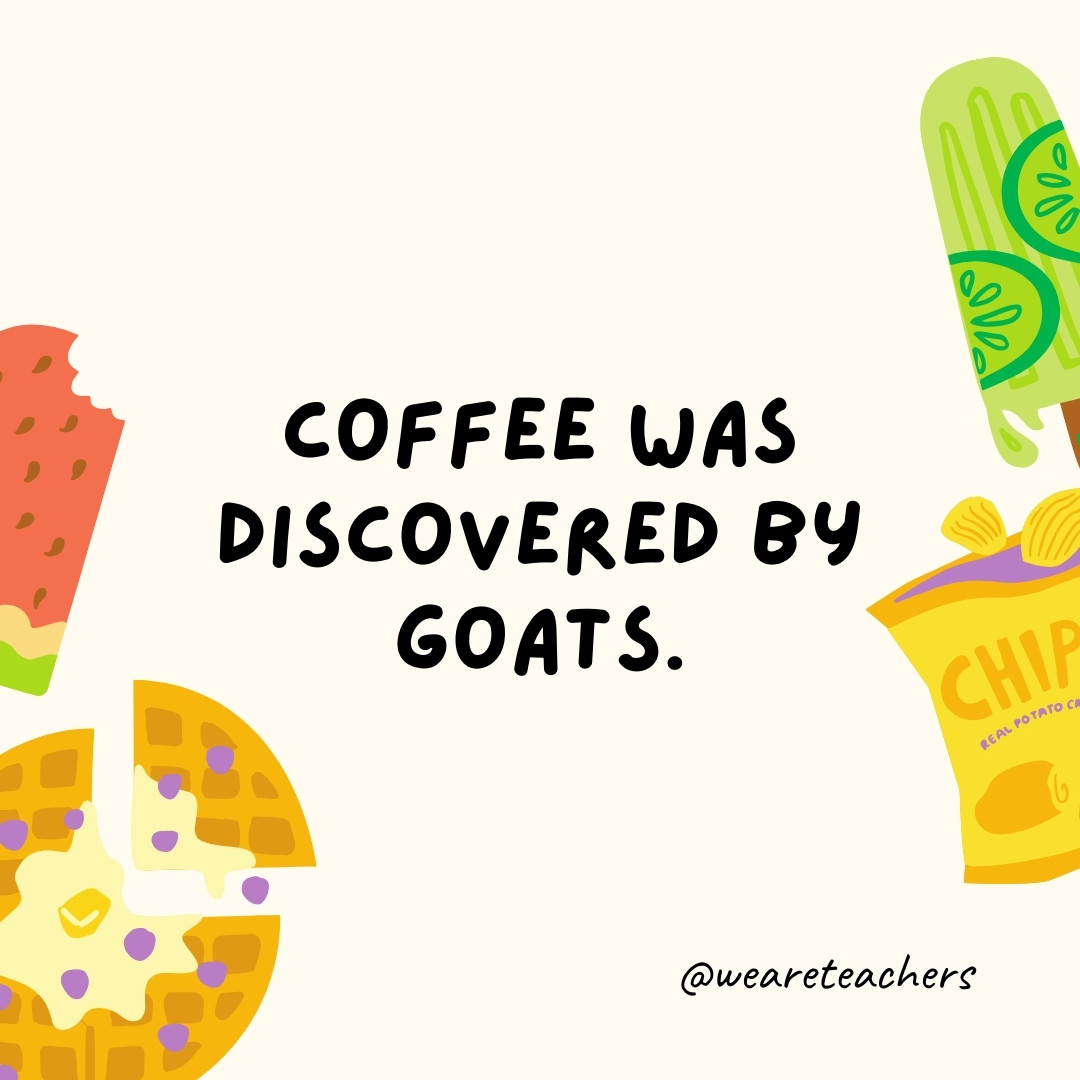
According to legend, a 9th-century Ethiopian goat herder discovered coffee when he noticed how excited his goats became after eating the beans from a coffee plant.
87. The sandwich as we know it today was popularized in England in 1762 by John Montagu, the 4th Earl of Sandwich.
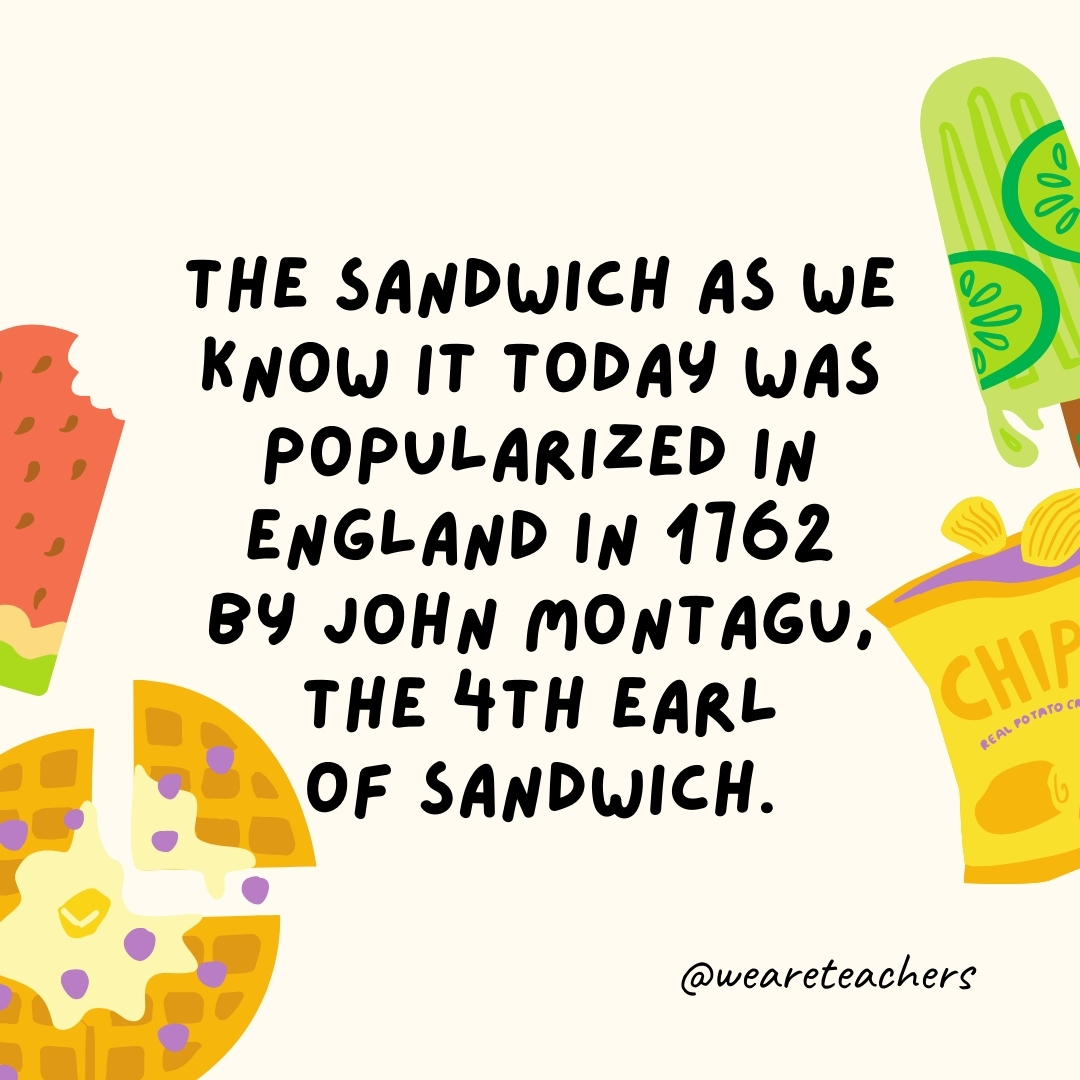
Montagu was a notorious gambler and often spent many long hours at the card table. During one particularly long binge, he asked for meat to be served between slices of bread so he could eat without interrupting his game. This request was the birth of the sandwich—people began to order “the same as Sandwich,” and the name stuck.
88. There’s an official water-tasting competition.
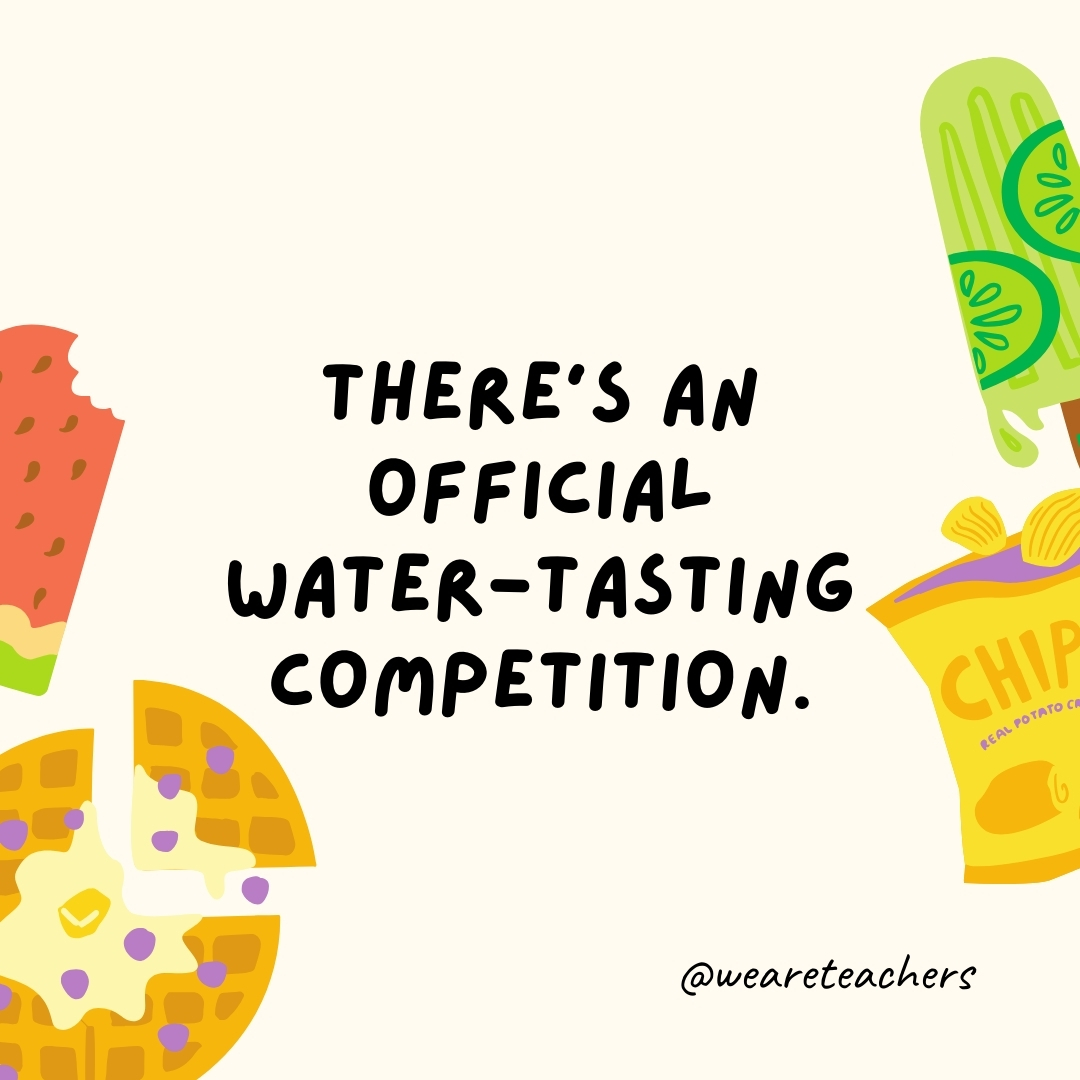
The Berkeley Springs International Water Tasting event is held annually in West Virginia.
89. Lachanophobia is the fear of vegetables.

Yeah, the fear might seem absurd to some, but it is a serious issue. Individuals with lachanophobia genuinely encounter symptoms like nausea and shortness of breath simply from seeing vegetables like broccoli or bell peppers.
90. Coffee was originally chewed.
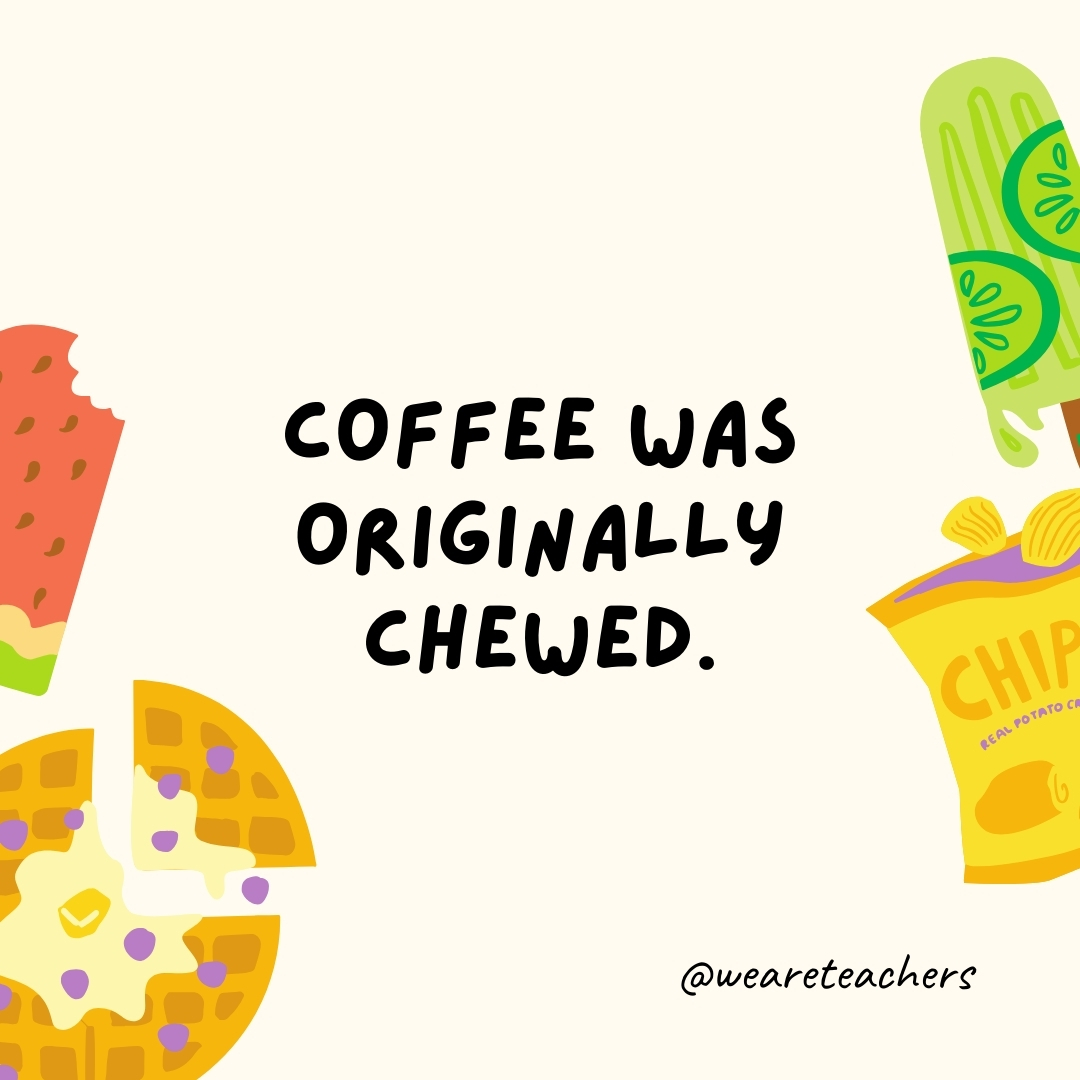
Before developing coffee into a beverage, people in Africa mixed its beans with fat and ate them as an energy snack.
91. Flamingos are pink because of their diet.

Flamingos eat brine shrimp and blue-green algae, which contain a natural pink dye called canthaxanthin that affects the color of their feathers.
92. The first-ever vending machine dispensed holy water.

Invented in the first century by Hero of Alexandria, an engineer and mathematician in ancient Egypt, the machine accepted a coin and then dispensed holy water.
93. Oysters can change gender.

Depending on which is best for mating, an oyster may change its gender one or more times during its life.
94. Eating fugu (puffer fish) is a culinary gamble.

In Japan, fugu chefs must undergo rigorous training to prepare this fish, as it contains a toxin 1,200 times deadlier than cyanide.
95. The world’s oldest surviving recipe is over 4,000 years old.

It’s a recipe for beer written in cuneiform on ancient Sumerian tablets.
96. Brazil is the world’s largest coffee producer.
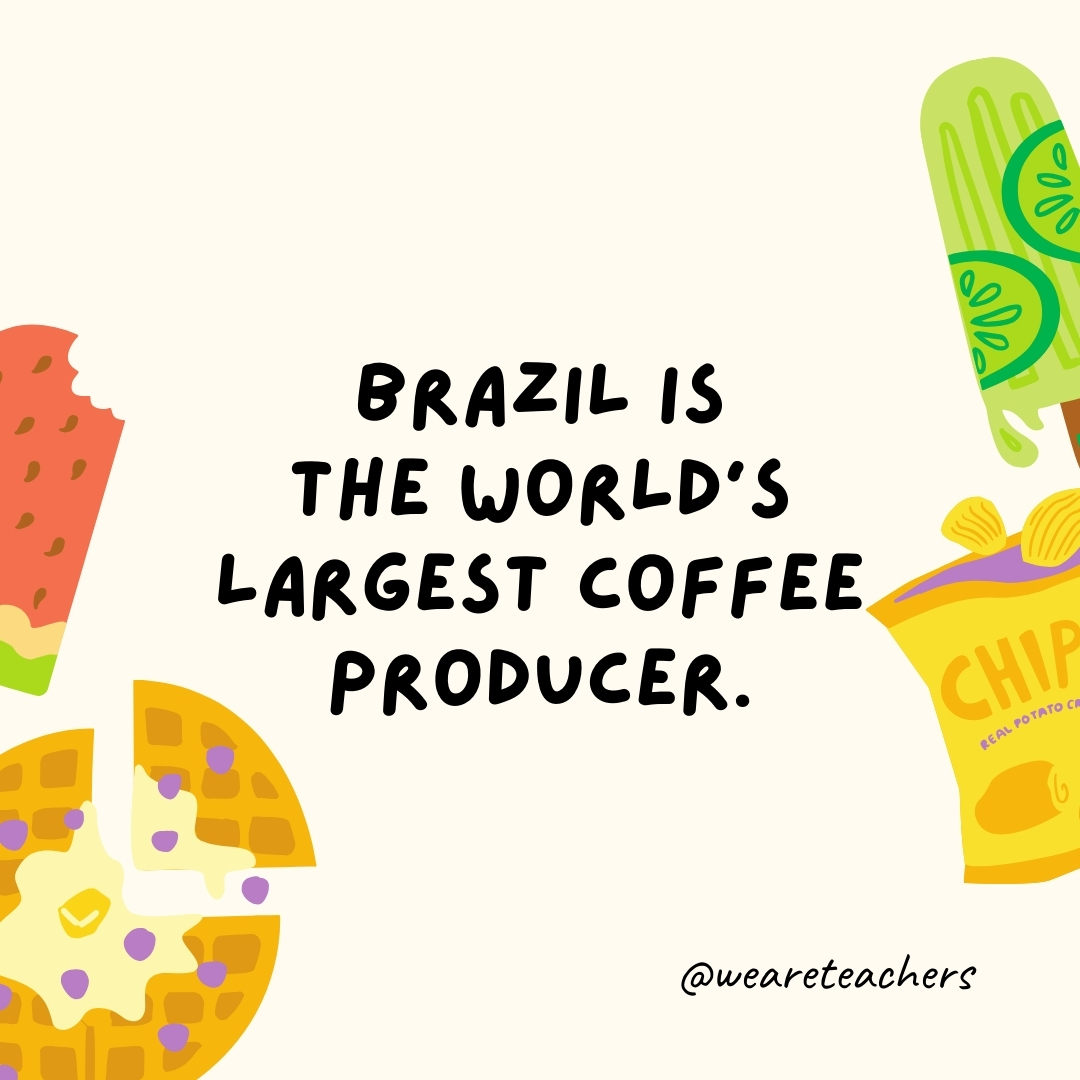
Brazil has held the title of the world’s largest coffee producer for many years.
97. A chef’s hat has 100 folds.

Traditionally, the 100 folds in a chef’s hat represent the 100 ways to cook an egg.
Record-Breaking Food Facts
From a super stretch of pasta to a cake nearly 11 stories tall, these food facts will make your jaw drop.
98. Pepper X holds the record for the world’s hottest chili pepper.

Pepper X dethroned the Carolina Reaper in 2023.
99. The longest strand of pasta was 12,388 feet long.
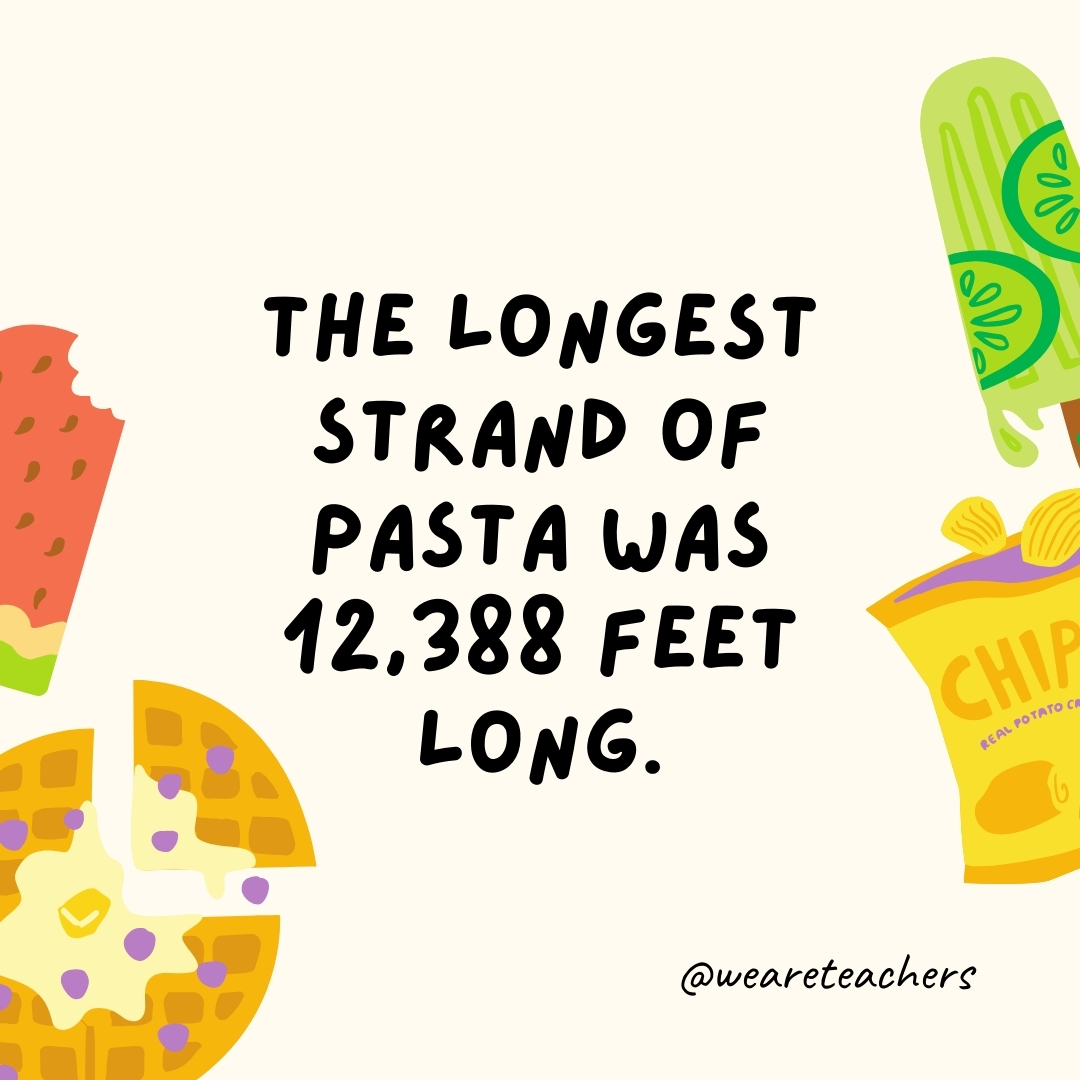
In 2010, Lawson convenience store in Tokyo, Japan, achieved the longest strand of pasta, measuring 3,776 meters (12,388 feet 5 inches), and incredibly, the entire pasta was cooked!
100. The tallest cake ever made stood at 108.27 feet.
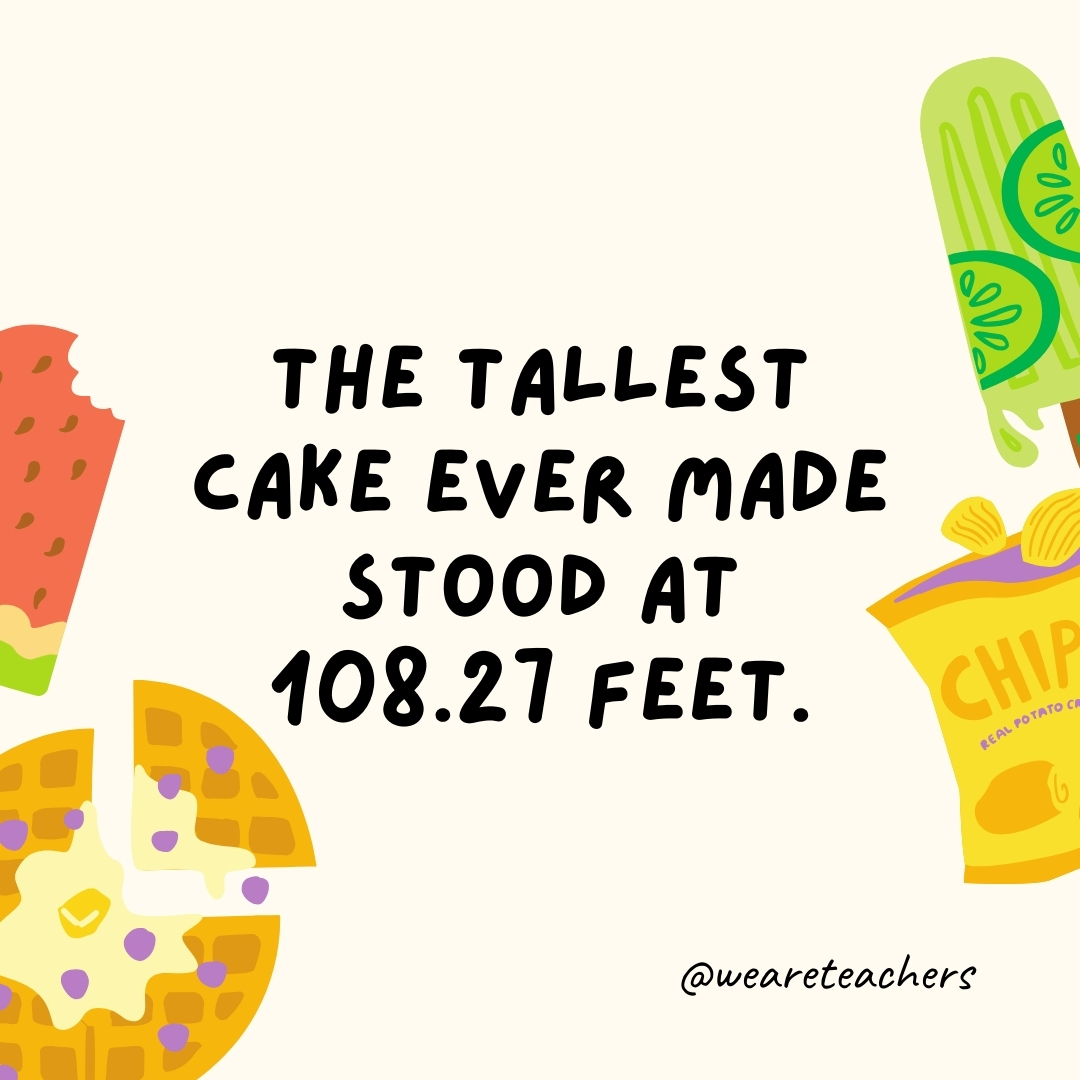
It was made by Hakasima-Nilasari Culinary School in 2008 for the Amazing Christmas event in Jakarta, Indonesia.
101. The world’s largest meatball was made in the Low Country of South Carolina.
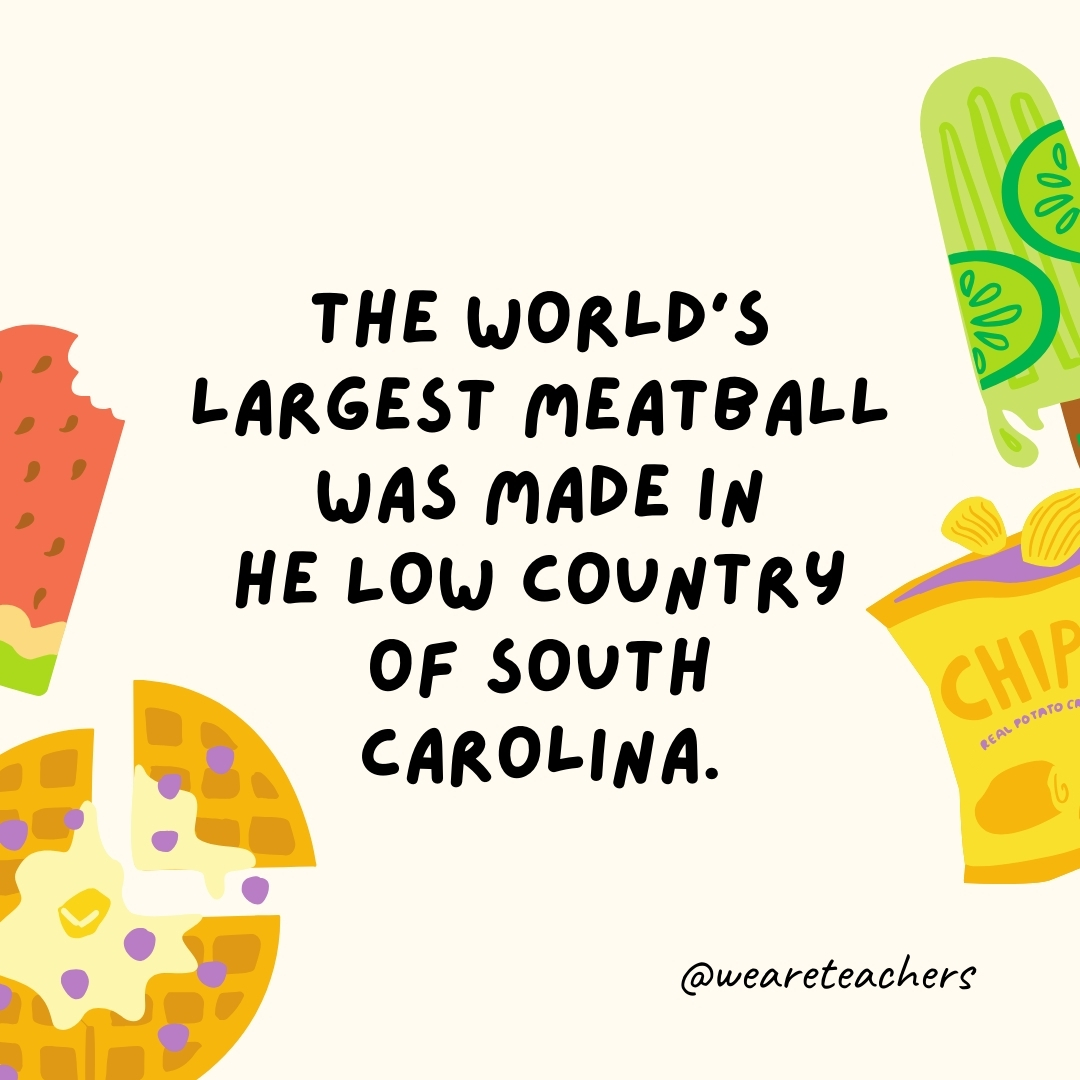
It weighed in at 1,707 pounds 8 ounces in 2017.
102. The heaviest fruit ever recorded weighed 2,749 pounds.
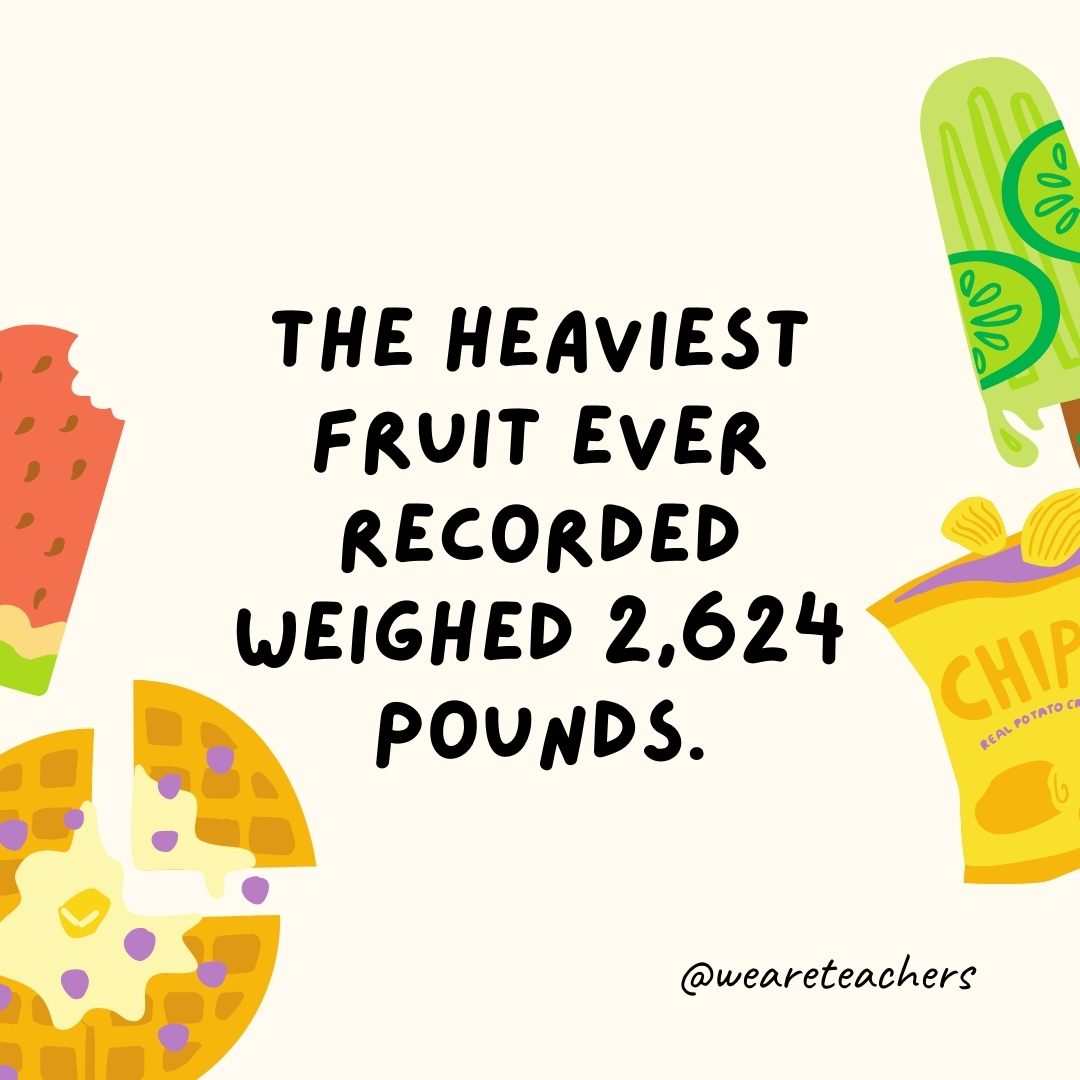
On October 9, 2023, Travis Gienger of the United States set a new record by growing the heaviest pumpkin, which weighed 1,246.9 kg (2,749 lb.). This may be one of the most shocking fun food facts!
103. The world record for the largest bowl of pasta was set in 2015.
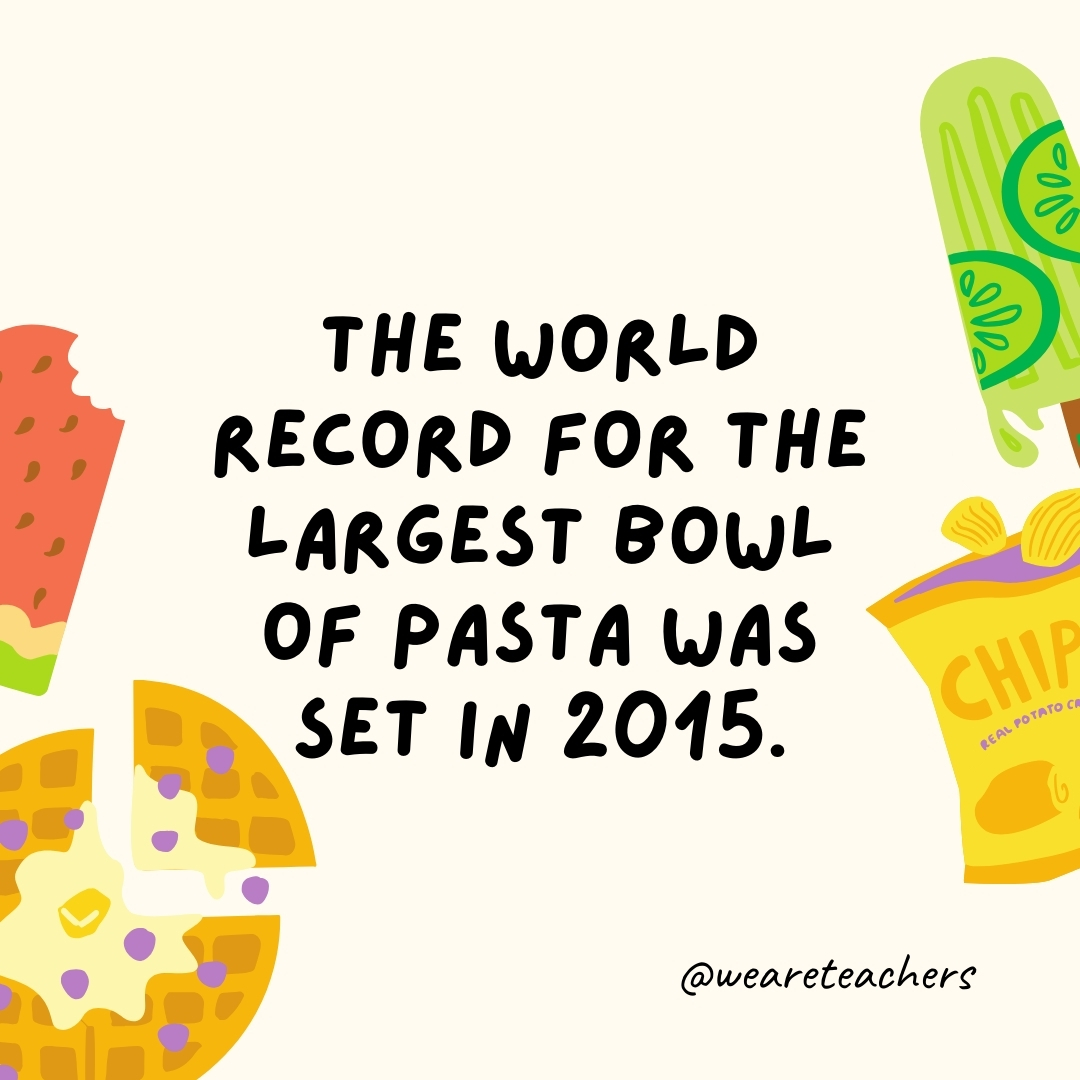
It weighed in at 17,417 pounds.
104. The most expensive wine is the 1945 Romanee-Conti.

In 2018, a bottle of 1945 Romanee-Conti wine sold at auction for $558,000!
105. The Guinness Book of World Records started with a feud over the fastest game bird.
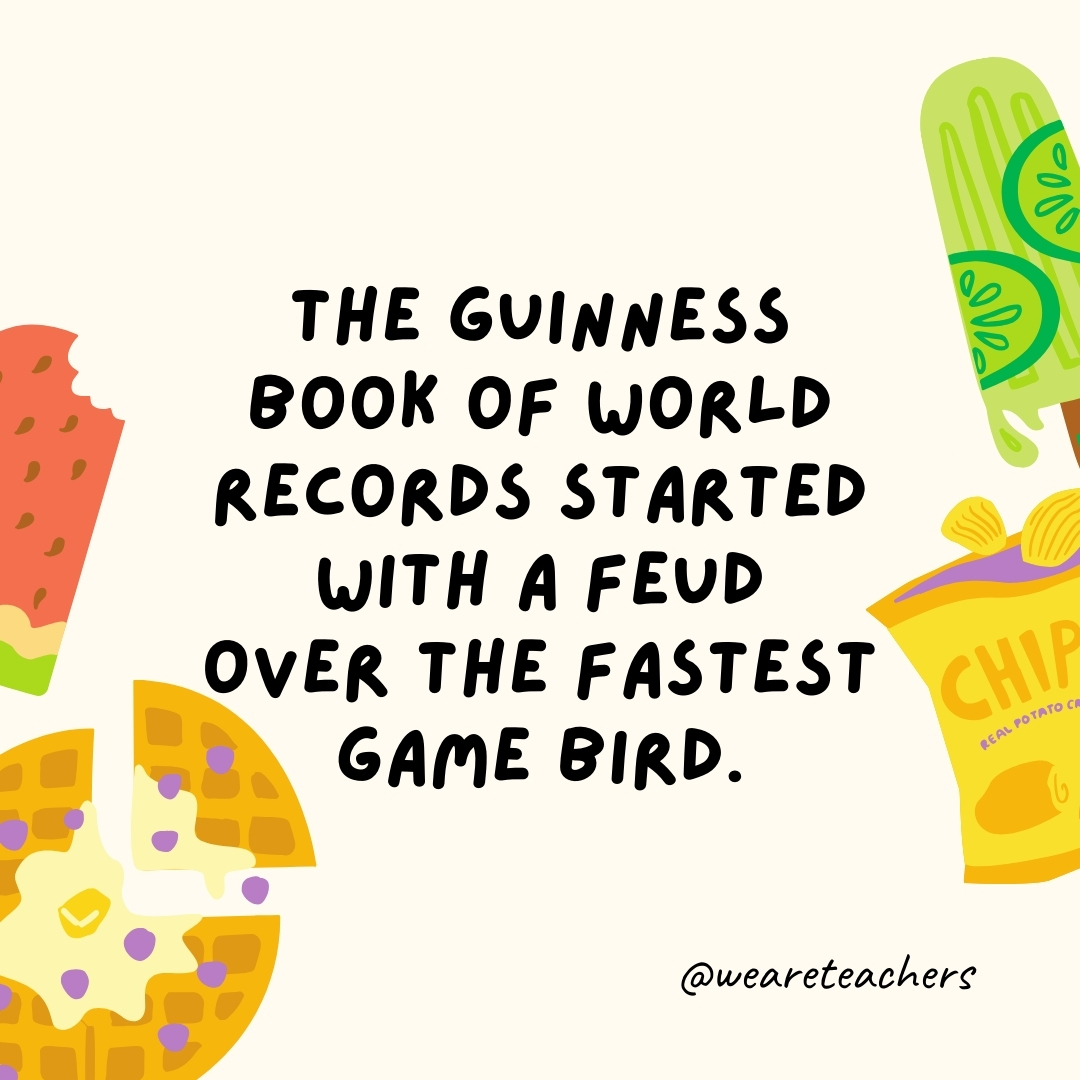
The first edition was published in 1955 to help solve arguments in pubs.
106. The Frrrozen Haute Chocolate ice cream sundae is the most expensive dessert in the world.
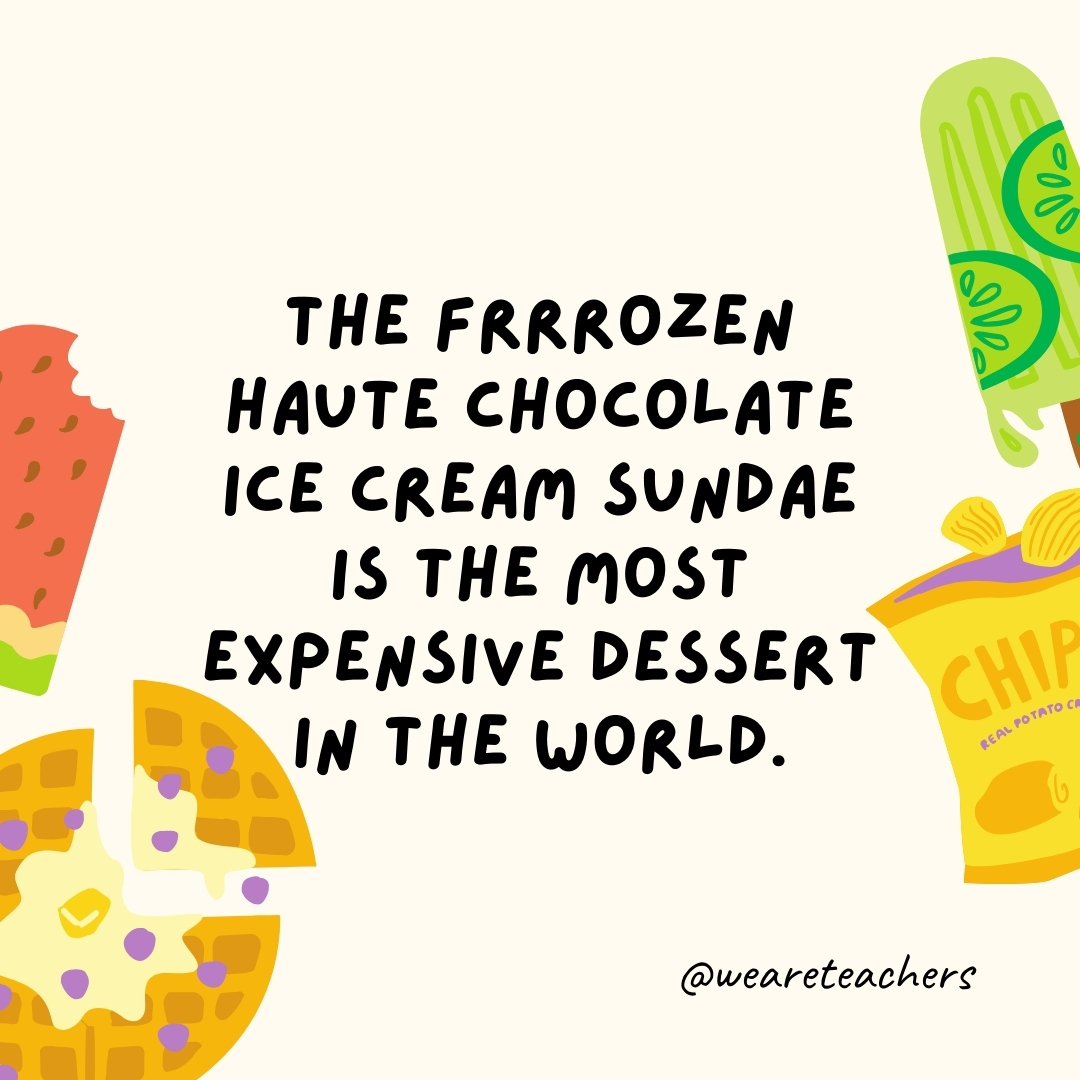
Created by Serendipity 3 in New York City, this sundae costs a whopping $25,000, which makes it the most expensive dessert according to Guinness World Records. A blend of 28 cocoas and edible gold is used to make it. See how it’s made!
107. The world’s most expensive cheese is made from donkey milk.

Pule, a Serbian cheese made from Balkan donkey milk, is the most expensive cheese in the world.
108. Canadians consume more macaroni and cheese than any other nation in the world.

Canadians eat a whopping 55% more macaroni and cheese a year than Americans and buy 1.7 million of the 7 million boxes sold weekly around the world.

